Hello and welcome, especially to all the new subscribers who have joined in the last few weeks, it’s wonderful to have you here. My posts are currently all free. However, words and food are two of the hardest fields to make a living in, so if you like what you read or find my work helpful, please consider pledging or upgrading to a paid subscription. Many thanks.
This morning. When I woke up, the light was hazy, as if it had been filtered through muslin. Weak Autumn light. Clocks turned back, leaves falling light. Holidays are past, winter is approaching.
We all do it. Once we’re back from our holidays, watching the rain pour down, wearing our thickest cardigans, cursing the clothes moths who've been busy in our absence. The heating is on. Christmas has, as usual arrived two months early in the shops. We’re left with memories of balmy beaches, non stop swimming, warm Summer nights. The rows, the bickering, the insect bites, all those memories have floated away with the tide.
Two weeks ago in Crete I was appreciating it all. All that I didn’t comprehend and still don’t know about Cretan food. This post isn’t so much sharing my understanding, as recognising, frustratingly, my ignorance and how much there is to learn. I’m grateful to Greek food expert Rosemary Barron for generously sharing her knowledge with me.
Before we departed for Crete, I opened up her evocative, authentic and authoritative Flavours of Greece to remind myself of what to expect, and to be inspired by easy to cook holiday recipes. Crete is the largest Greek island with a UNESCO-protected food heritage. From where we’re staying, to the East of Chania, it’s another two and half hours further east to Knossos, the Minoan palace famed for the legend of the Minotaur, Ariadne and the labyrinth.
On our wish list for myself and my friends Liz and Moy, a place with our own pool, within walking distance from the sea. We find it, just outside a little village about forty minutes from Chania. It has plenty of restaurants and cafes, a bakery and grocery store. Who doesn’t love it when their holiday rental comes with a gift box of local produce? Heading upstairs to our kitchen we find milk, juice, jam and a bottle of the owners own olive oil.
Rosemary told me; Go to the Saturday market in Chania, and go early, before 9am. We’d decided not to hire a car as yet. Finding the bus timetable and bus stop is our own modern Greek epic. Having dutifully managed an early start, we arrive at the bus stop in time only to find that the online times were wrong. Pinned to a shop door are the correct times which everyone else obviously knew about because come 9.45am, they all roll up.
The journey to Chania passes by Souda bay, once occupied by the Venetians who’ve left their mark on Crete, and is both a Nato stronghold, and a destination for giant cruise ships. We saw evidence of both during our stay with war ships in the bay, air force planes overhead, and hordes of tourists in the back streets of Chania.
Approaching a market, I’m always on the lookout for people carrying bags of fruit and vegetables, trolleys tumbling with greens. We saw the familiar sight of canopies and vendors from a few streets back. And then, at the market, a new untried market, which way to go? Who has the freshest, best value produce, where would we find the best tasting cheese, honey, olives. To the right, the market slopes down to a cross roads, and over the road the market continues in a different vein with clothing and household goods. Here, on this side of the street, everything is about food, as stalls trail down, close to the sea and the Sabbionara Bastion, the remains of the Venetian sea walls.
Stall holders call out, offering tasters, drinking glasses of raki and coffee. Everyone seems to be in a good mood. Tables piled high with freshly picked mountain greens, grapes, oranges, prickly pears. Only one or two stalls have figs, the last of the season, instead there are persimmons, pears, apples and pomegranates. Stall after stall of the freshest looking produce. No meat or fish here.
My adage if in doubt, is look for the stalls with the longest queues of locals. There were a few tourists, mostly buying honey and olives. The disadvantage for anyone who doesn’t speak Greek is to understand what’s being sold if it’s not obvious.
Stall holders here are visibly proud of their produce; some sell only one thing; freshly picked oranges. Beetroots on a stall, large bunches, probably over a kilo but the man lets me separate them out when I indicate how many I want. No problem.
Rosemary Barron to the rescue when I ask her to identify some of the vegetables for sale; This is celery - here grown for its leaves, not root or stem.
Fresh courgette flowers, I can’t resist. We can’t deep fry them but I’m sure they’ll bake, stuffed with the fresh ricotta like Myzithra cheese I’ve just bought, mint, lemon rind and some of the local graviera, hard sheeps milk cheese.
Cucumbers are plentiful, slender and sweet. We’d love to buy a melon after stopping to taste but it would be madness to carry one around with us. Piles of pomegranates and prickly pears. Liz buys organic pomegranate juice. It’s delicious. Pomegranate juice reminds me of winters in Istanbul but this is fresh and better than anything I’ve had before in Turkey.
Piles of Autumn coloured chestnuts next to russet apples and bunches of different grape varieties. Borlotti beans, ready for podding. Squash leaves and tendrals. I’ve only seen these before at Italian markets.
Bags of snails, another Cretan specialitiy. Tomatoes; end of the season, some are green, others that look as if their juices will burst as soon as they’re picked up.
The grapes I buy are tiny, yellow-green and sweet as honey. I’m surrounded by people buying generous amounts, and when I say generous I mean huge quantities. Compared to the half kilo of grapes I’m buying, the man next to me could start his own winery. When I join my friends in the shade of a market cafe, we spot huge bags of oranges under tables, greens and salads stuffed into wicker bags. I don’t know how many people they’re cooking for but we already know just how generous the portions in restaurants are.
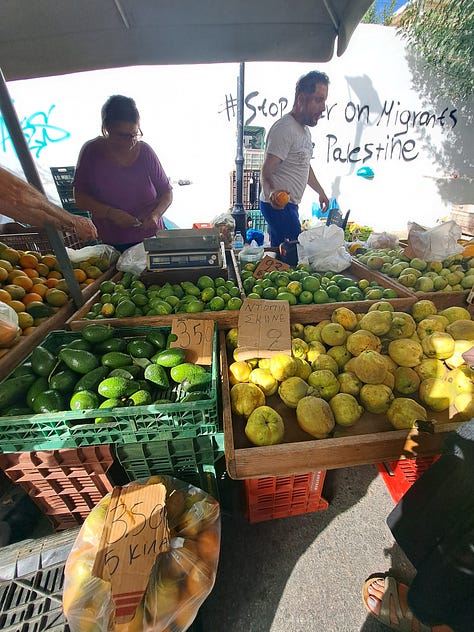
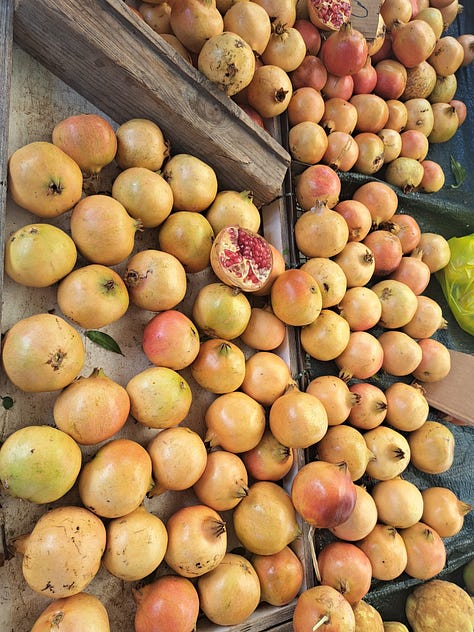
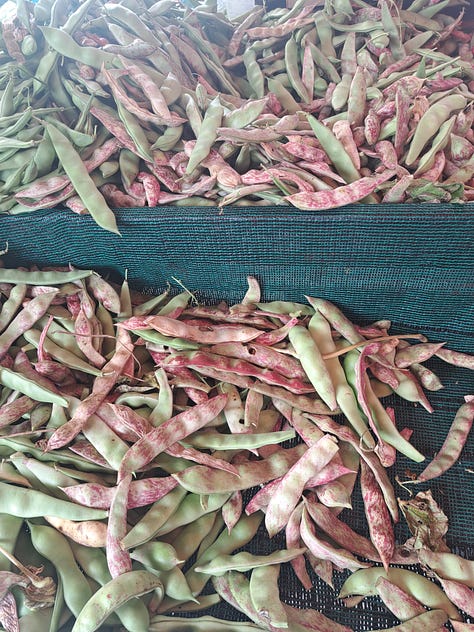

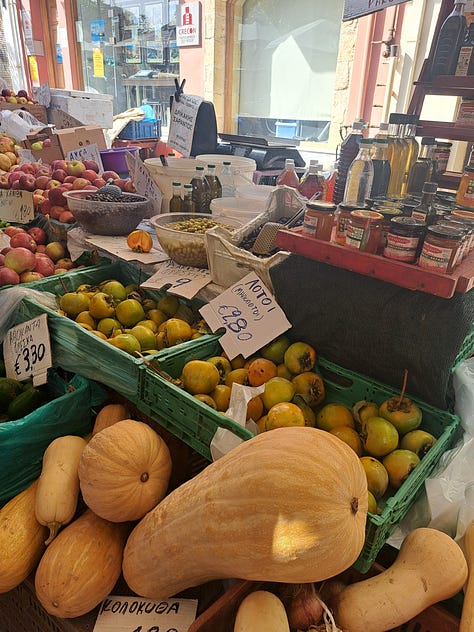
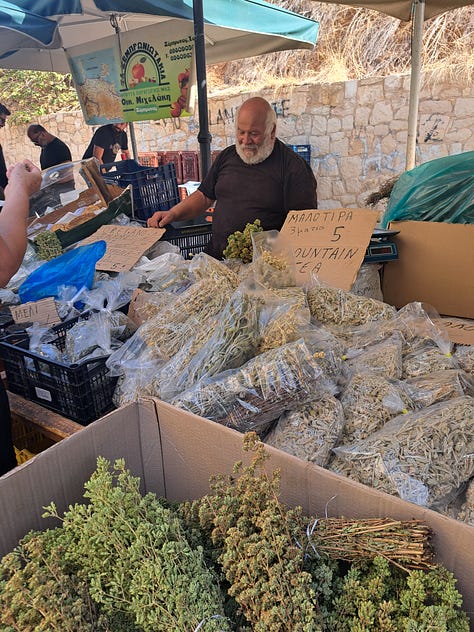
I wish I’d taken a photo of all the food shopping we bought. Naturally the feta we buy is so much nicer than anything we can buy in the UK, another cliche of holiday eating but it’s true. The same goes for the dense and creamy Cretan yogurt and fragrant thyme honey.
I’ve fallen for the local Dakos salad; Cretan barley bread rusks soaked in olive oil, topped with grated tomatoes, soft Myzithra cheese, olives, oregano and more olive oil. Served above like a bruschetta, or the rusks are mixed in, the salad dressing juices soaking into the rusks. We ordered it on our first night, learning immediately that portions of starters and appetisers are generous. Dakos is a perfect example of how something so simple is made delicious by good in season ingredients.
Lunch today is another recommendation from Rosemary; a few blocks back from the Venetian harbour, sits Chrisostomos. Traditional, wood oven Cretan cooking, with ingredients from Sfakia in The White Mountains (or Madares as the local call it) in the southeast of Crete.
Their house salad is made with fresh stamnagathi, lettuce, green onion, dry anthotyros cheese, walnuts, pomegranate seeds, dakos-cretan rusk, sweet and sour dressing. It's the best salad we order all week.
I ask if their rabbit is wild or farmed. Often this question is met with a blank look but here I'm answered immediately. Farmed.
Ofto; roast ribs and shoulder of lamb (Cretan cut) served with baked potatoes is simply cooked with olive oil and salt. It's delicious.
Cretan cheese pies. Lamb sausages.
We never need to order something sweet at the end of a meal as it's automatically brought to the table with a little carafe of Raki, also known as Tsikoudia.
We're brought a plate of Loukoumades to share. Last night the raki was rough. Today it's chilled, and with the sweet honey syrup covered dough puffs, it's acceptable. Just. To some of us it's still paint stripper.
Back home we have a feast of the freshest vegetables to cook with. The courgette flowers are stuffed with ricotta, mint, hard cheese, lemon rind and baked.
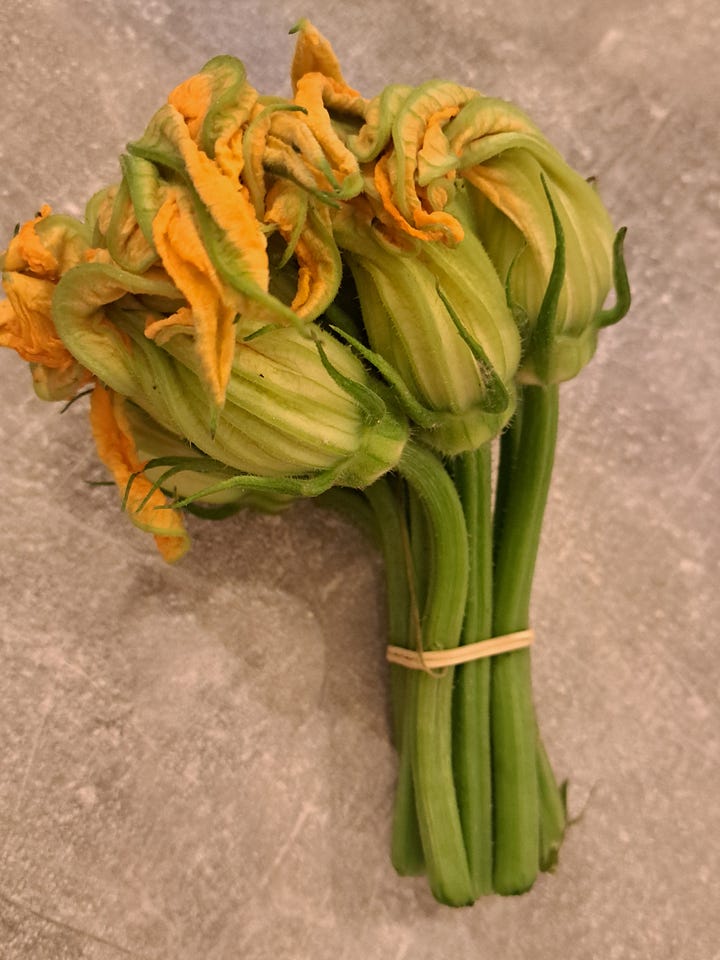
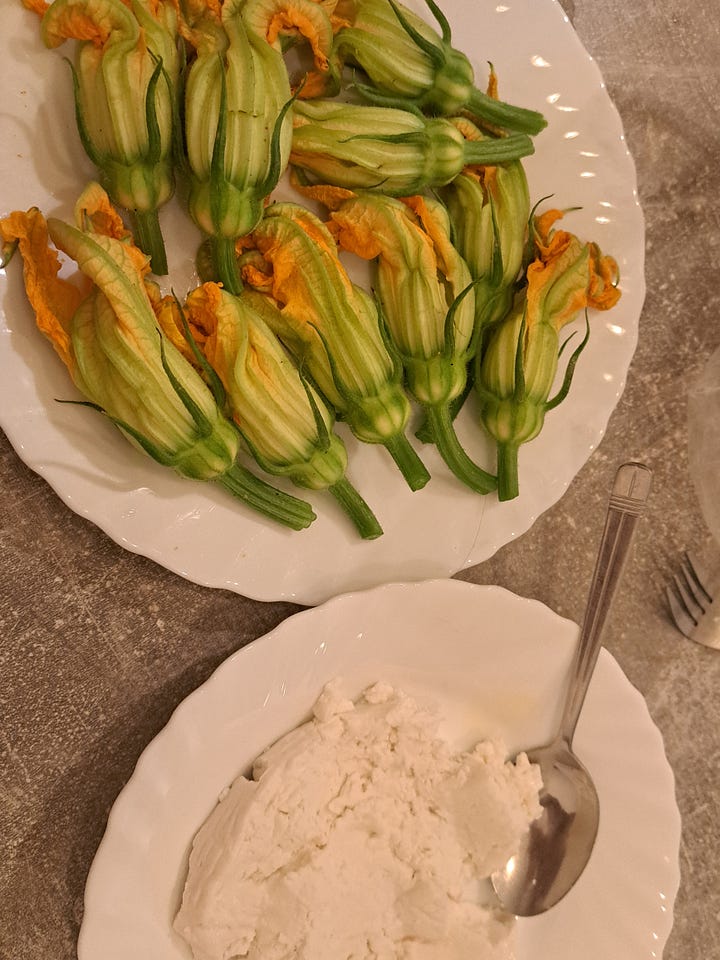

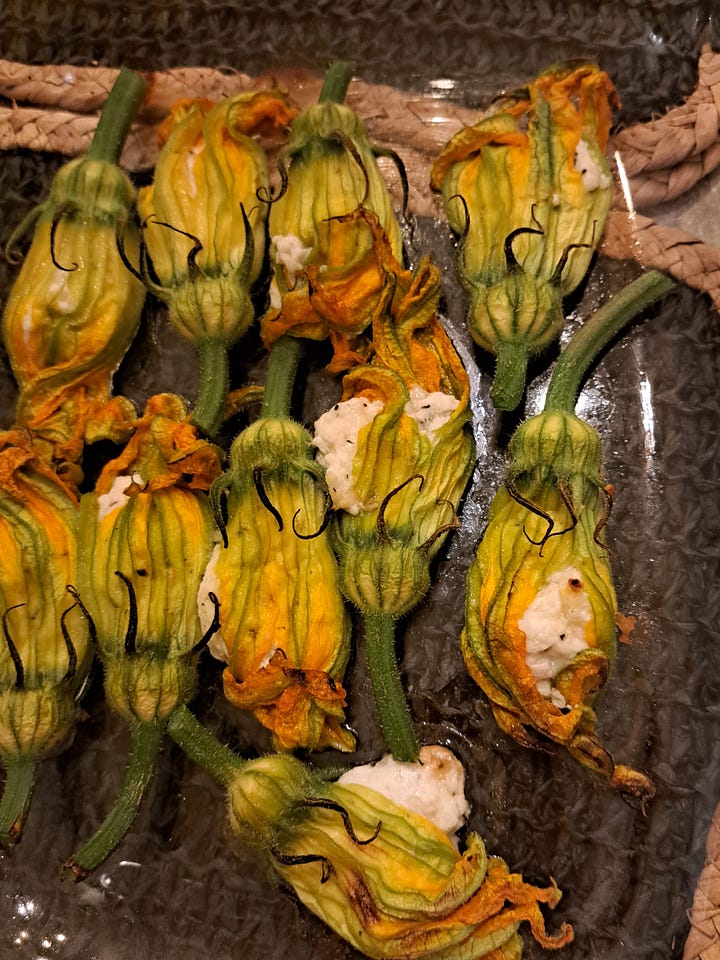
Beetroot and orange salad. A simple salad of the market feta, cucumbers, olives, tomatoes, our olive oil, oregano. Tzatziki, easily made with Cretan yogurt, cucumbers, garlic, olive oil and salt.
Our hosts recommend a trip to Georgopolis to see the chapel on the rocks; built out on a narrow rocky causeway. We watch people carefully make their way along the rocks. Personally I’ve had enough of balancing on rocks after a long, long hike along the Imbros gorge and enough bouldering to last a lifetime. We head instead for the local bakery.
From the outside, you could easily pass it by. Thanks Liz, and google maps.
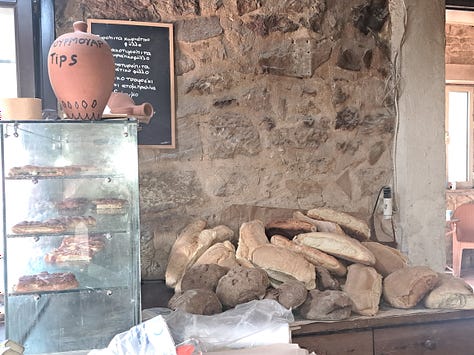
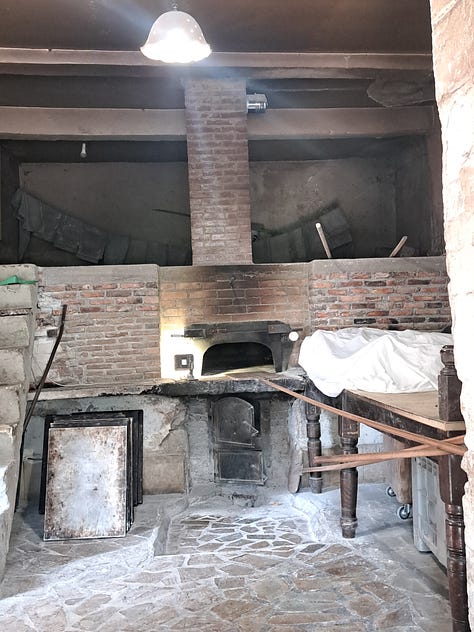
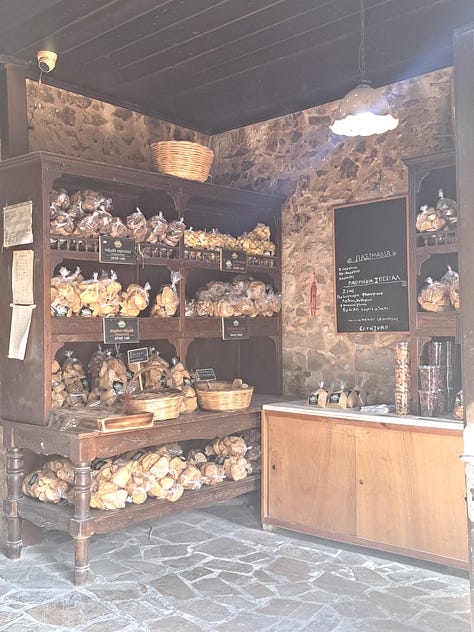
As you can see, it’s a wood fired bakery. Everything made from scratch by hand. We buy olive bread sticks and raisin bread. A huge loaf of bread is gratifyingly heavy. When we later cut into it it’s dark, sweet and dense. Barley bread? I wish I knew. I also wish I’d had room to bring back some of his other products; biscuits and rusks. His spinach and feta pies, tasting faintly of mint are the best we try all week. There’s little information about the bakery online but I found that the bakery was started in 1948 by two brothers - Manousos and Ioannis Foundoulakis and was the first of its kind. Another source claims that it’s the best bakery on Crete; the reputation of the bakery precedes it all over Crete and as far as Athens.
Towards the end of our week we head to the Thursday Iraklion market, and nearby Knossos, a good two and a half hours journey. Moy is a great driver. We're lucky when we arrive, a parking spot opens up near the market. If you look for the market online it’s often called an Open Air Bazaar but don’t expect a flea or antique market. This is an everyday market.
It's busy. From across the road, this market has the feel of a car boot sale, but once we're in we can see there's a clear division. Fresh produce to the left and around the edges. Clothing and household goods to the right. If this was the UK I'd expect to find low quality bowls of fruit and vegetables. But, this is Crete. Stall after stall of seasonal produce.
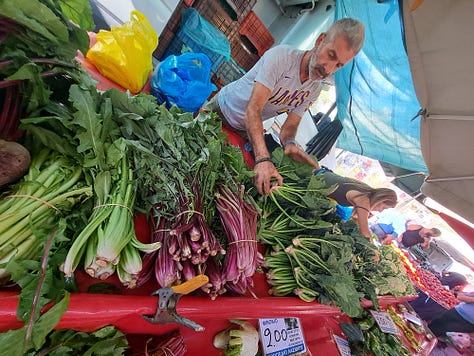
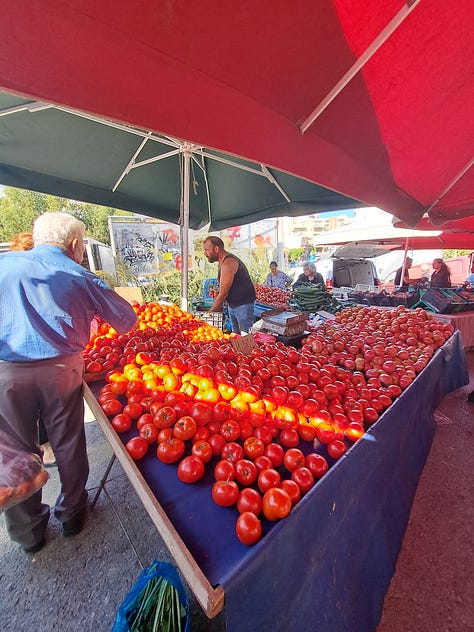
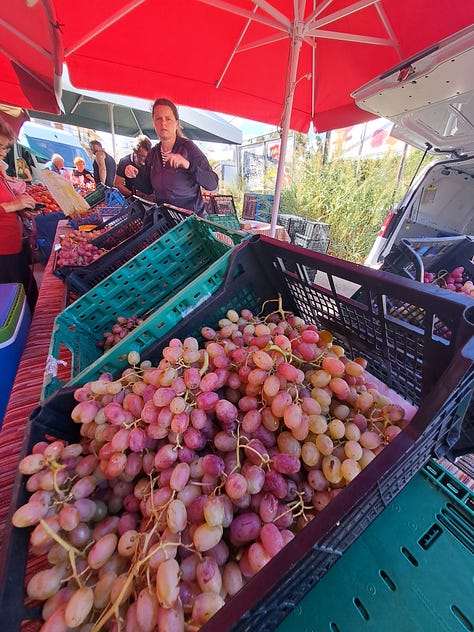
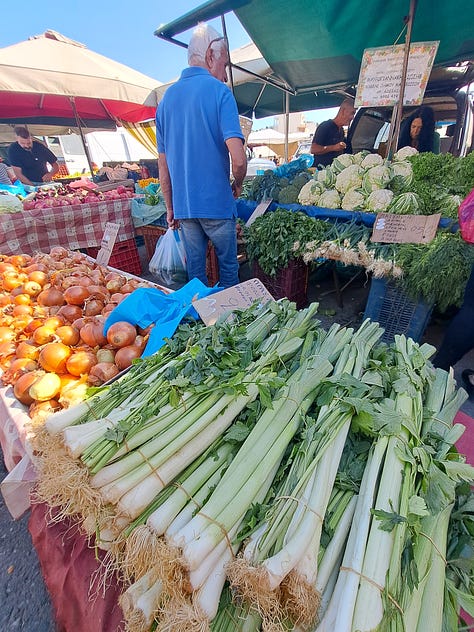
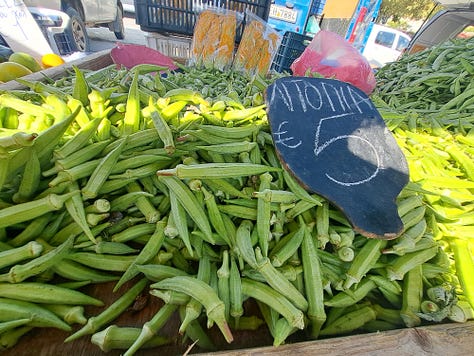
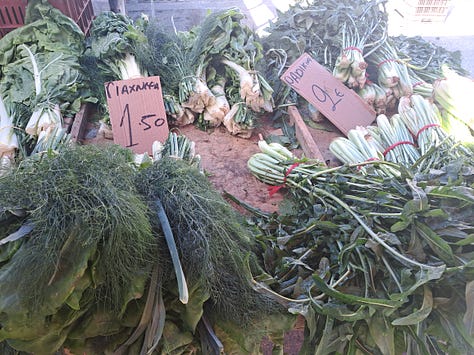
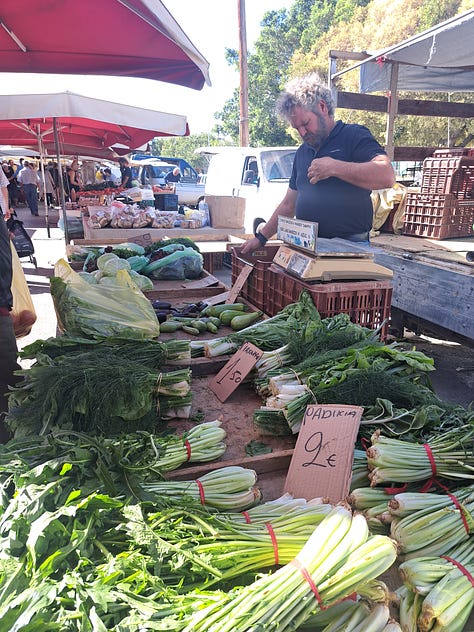
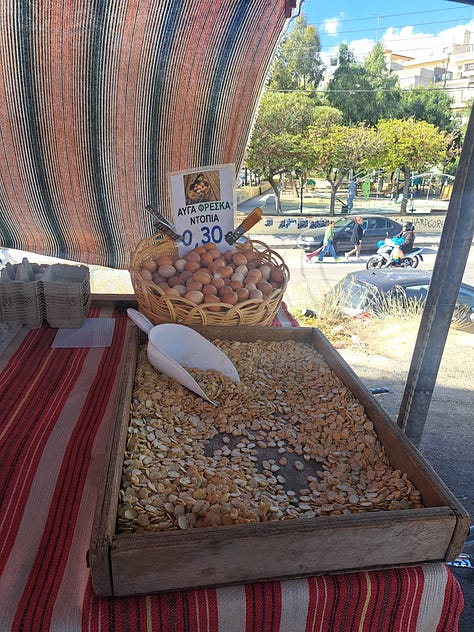
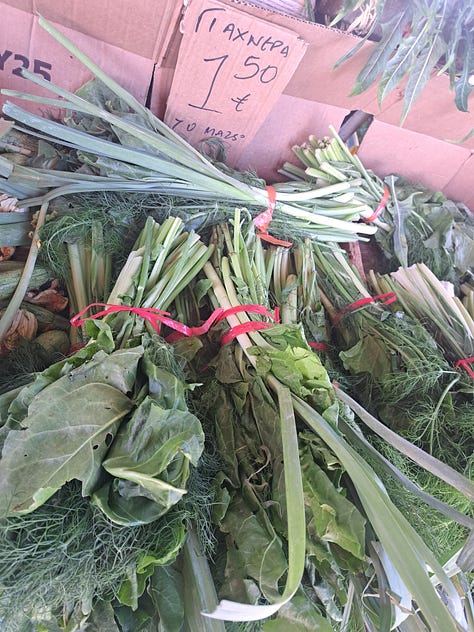
One stall is just selling pomegranates. Best quality to the left, cracked open to the right. The cost for two perfect bright red globes is 50 cents.
Here there are fish stalls, the bright eyed catch, tails curling denoting the freshness.
More unidentified wild greens. These are vineyard beans (colloquial name), or fresh black eyed beans.
Asklimbros, an edible thistle, a Horta, or wild green. Horta, that collection of wild greens best beloved of Greek menus. The first time I came to Greece, to Corfu, I saw Horta on a restaurant menu and ordered them, even though the waiter did his best to persuade me that I wouldn’t like them. ‘Too bitter’. He was right, Very bitter, but I wasn’t going to not eat them.
Stalls are covered with bunches of herbs and something I would love to see in the UK but have only previously seen in Germany, France and Austria; a flavouring mix of vegetables and herbs tied together and ready for the pot; a leek, herbs, a carrot, maybe a Hamburg parsley or often, a stick of celery. Sometimes, many times, I don’t want to buy a whole celery.
A stall crowded with shoppers, the tables covered with bunches of miniature bananas. I assume they're imported but Liz is right. We did pass glasshouses full of banana palms. And later I read about banana production on Crete mostly in the southern district of Arvi.
Out of the three or four cheese stalls, I choose one with a queue, taste and buy a piece of sheep's milk cheese to take back.
A stroll through the other side of the market, looking for t-shirts for Moys children.
A man is standing on a table, encouraging people to buy. By the look of the crowds, they don't need much encouragement.
Before we leave we buy a small watermelon. It's honestly the sweetest I've ever tasted. (I later wish we'd brought the remains with us when we're waiting in the airport for our delayed flight.)
There's only so much I can buy. We're going home tomorrow and I have to think about the capacity of my suitcase and the bags of rusks, herb teas and pomegranates it has to accommodate. Fully aware that we’ve barely chipped the corner off Crete, we’re already thinking about next year.
I leave you with the sound that will keep me going through winter, one foot and a sheep bell in Crete.




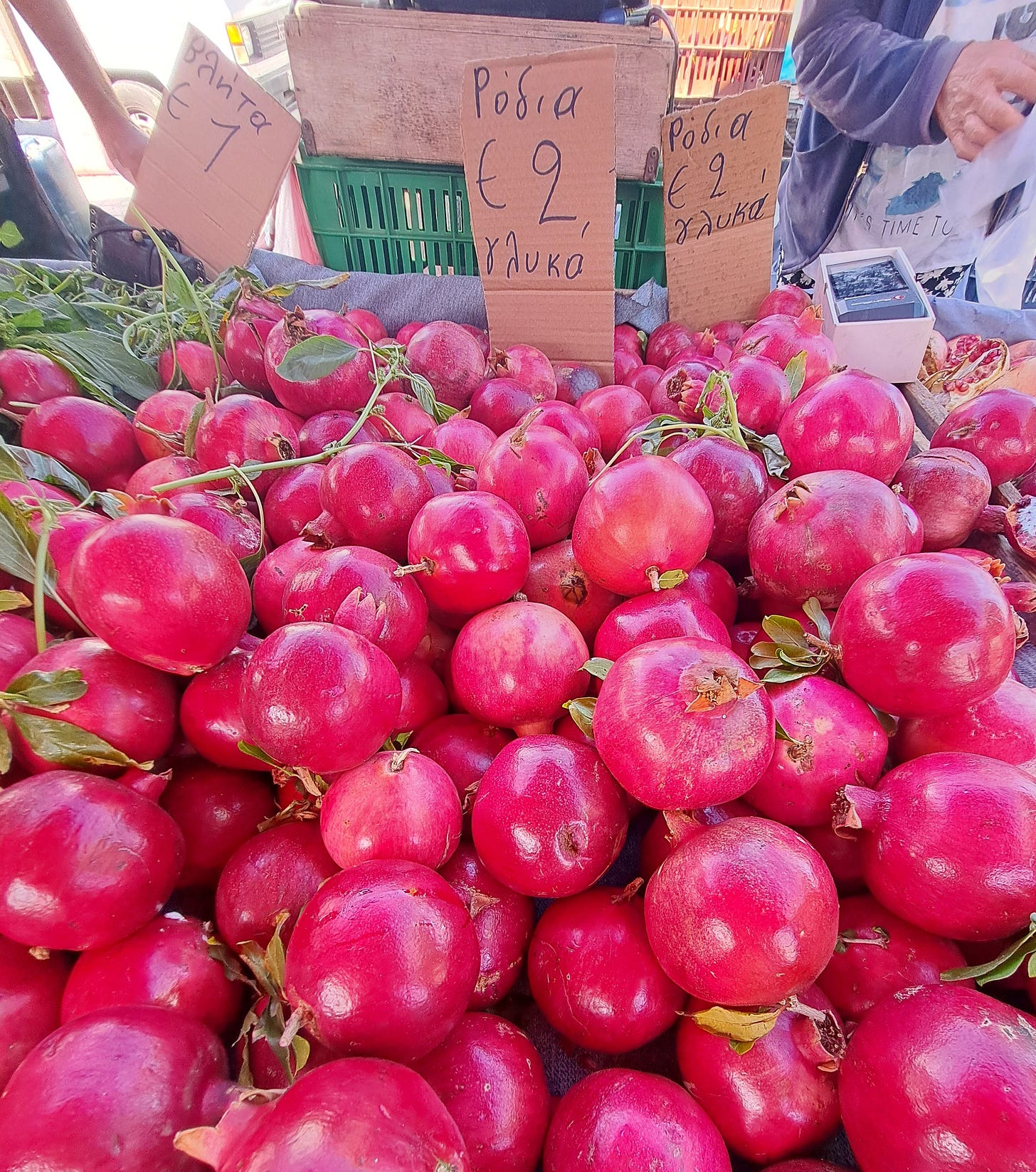
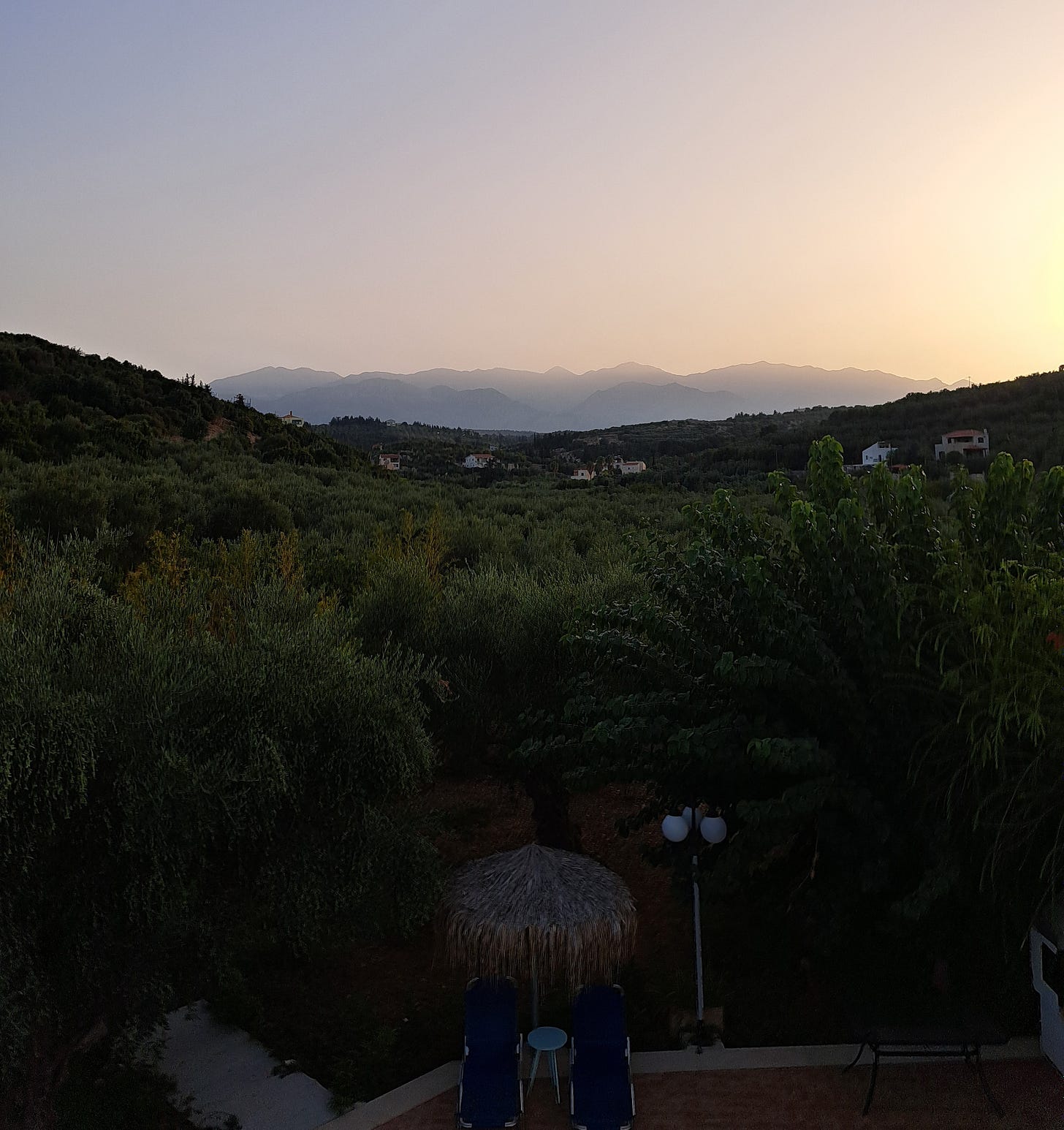
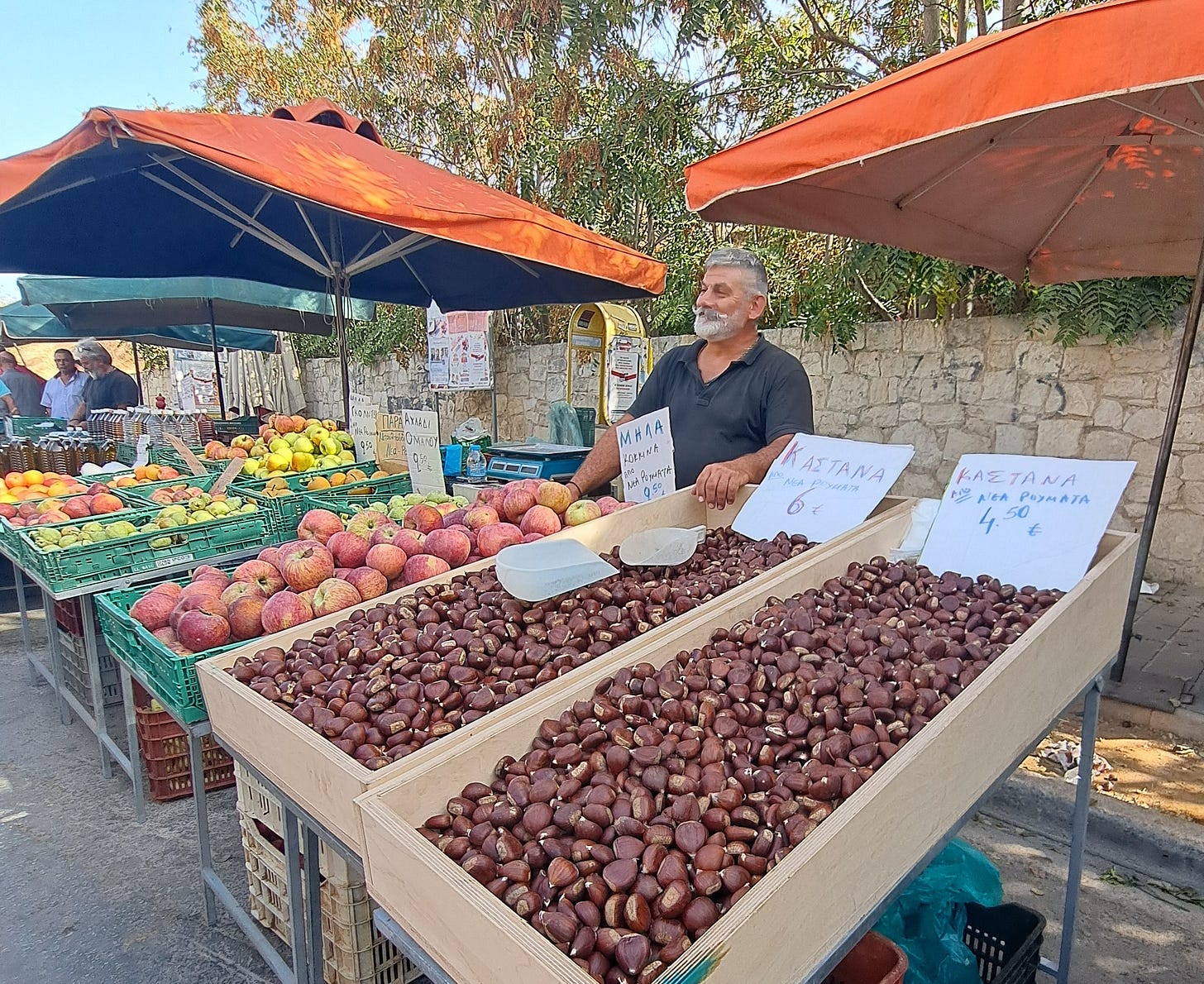
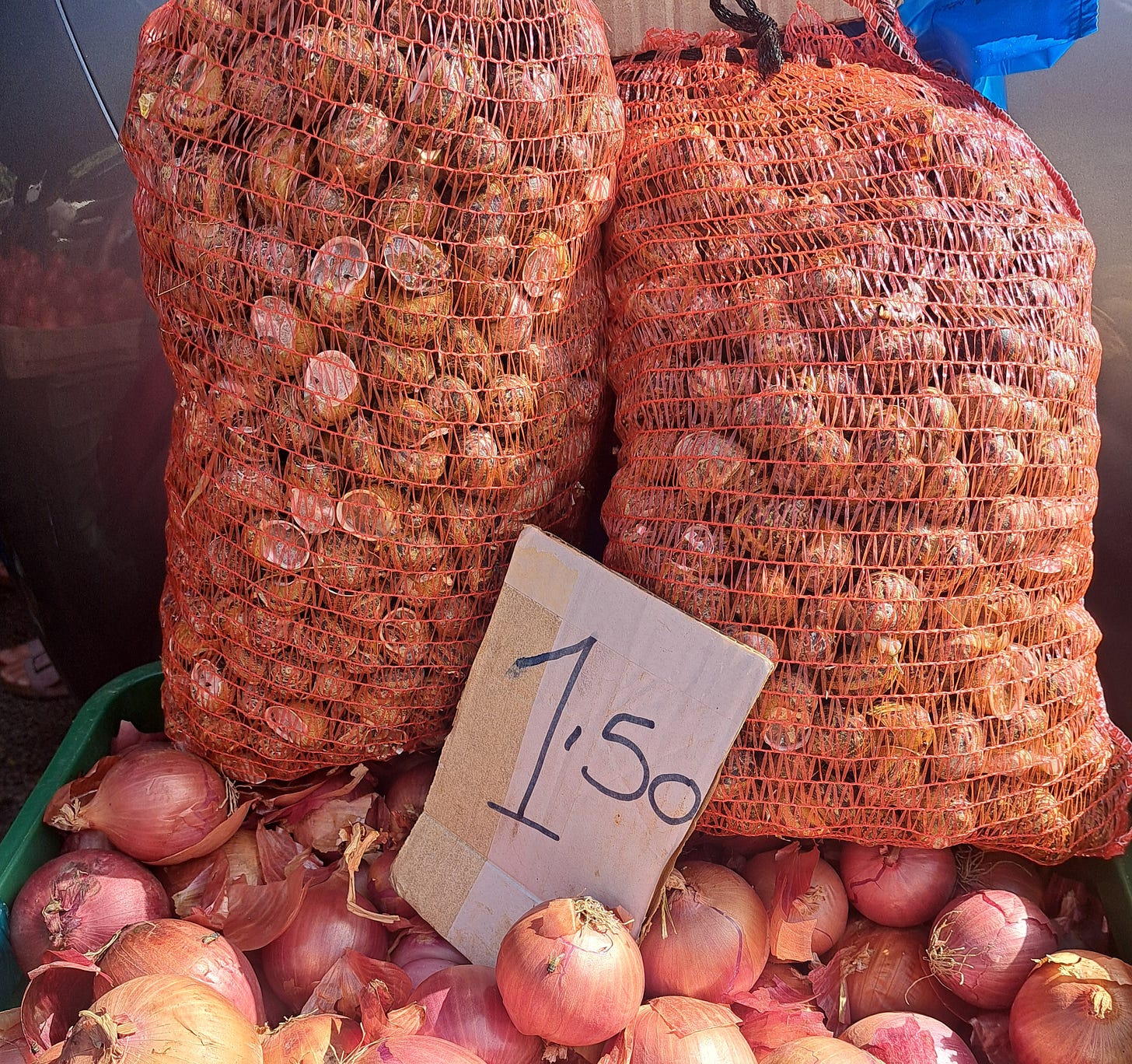
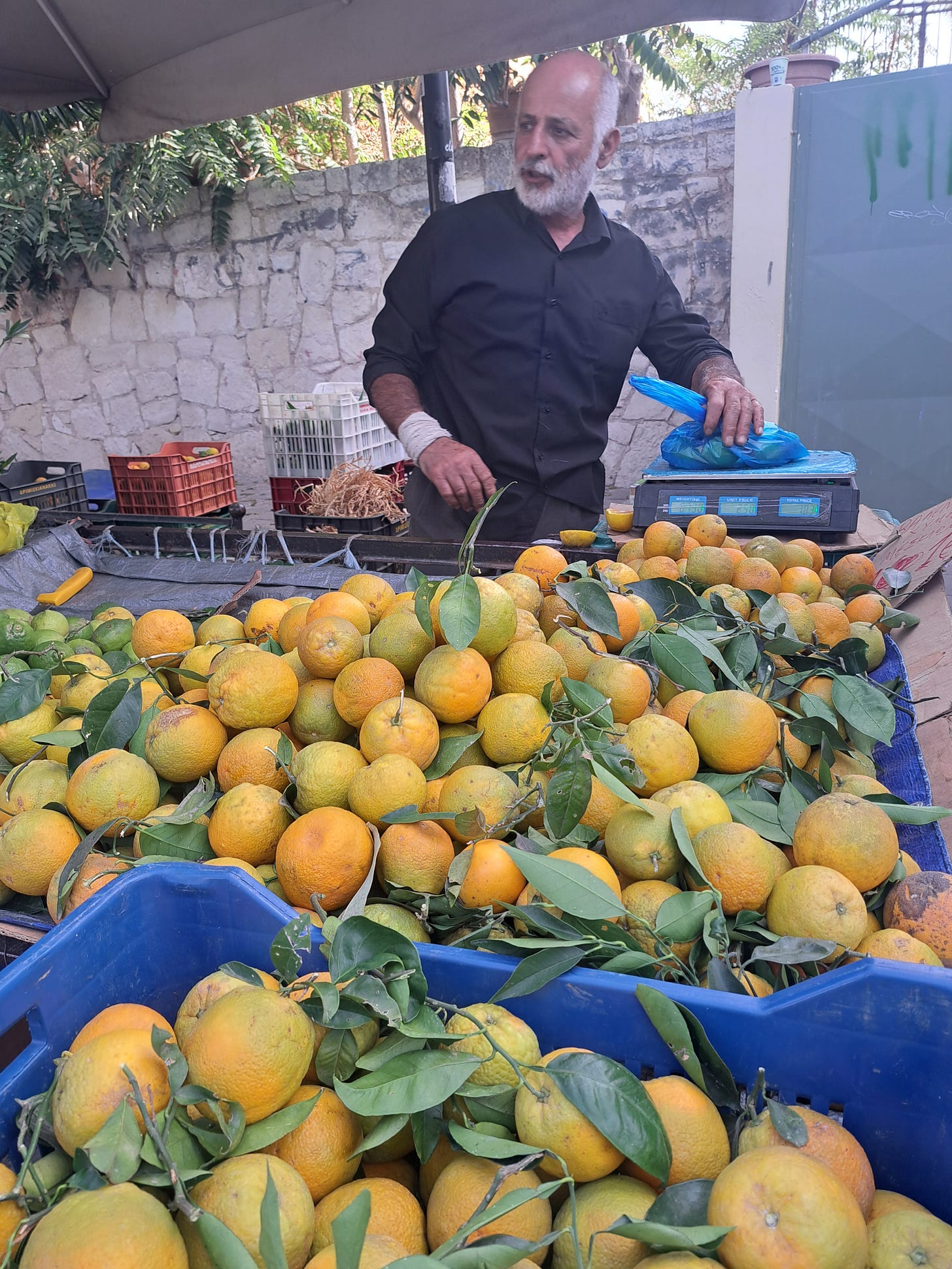
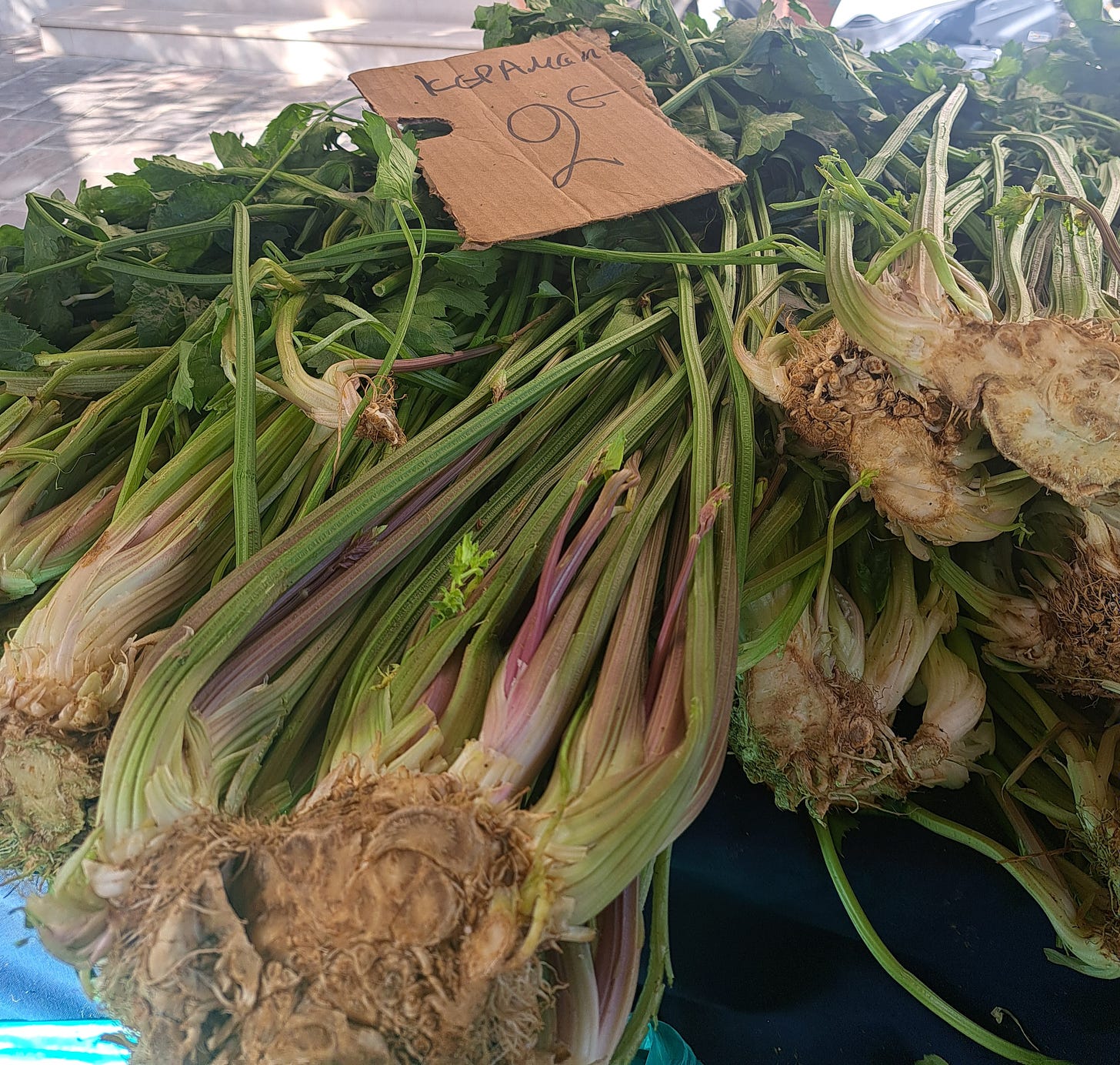
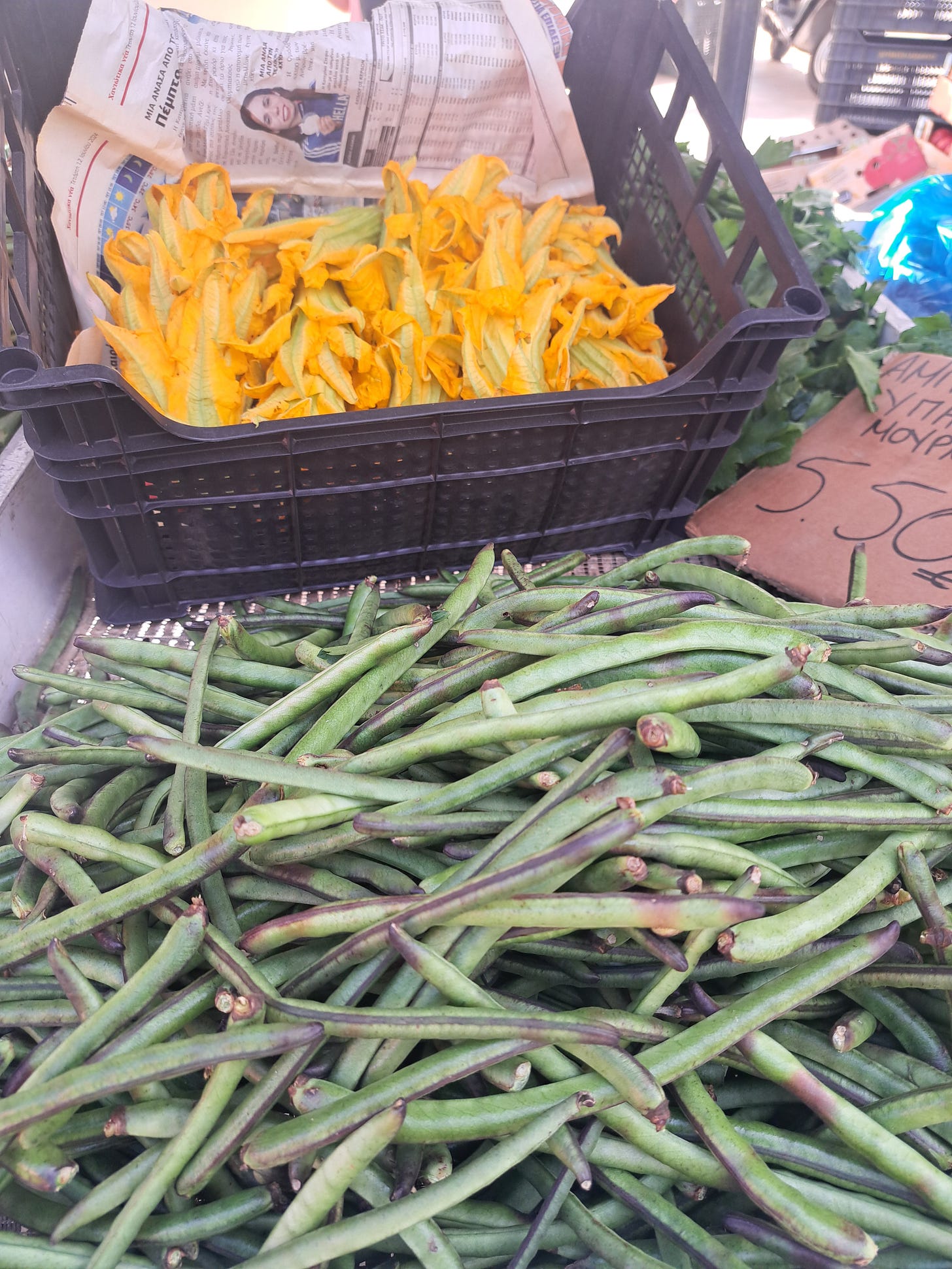
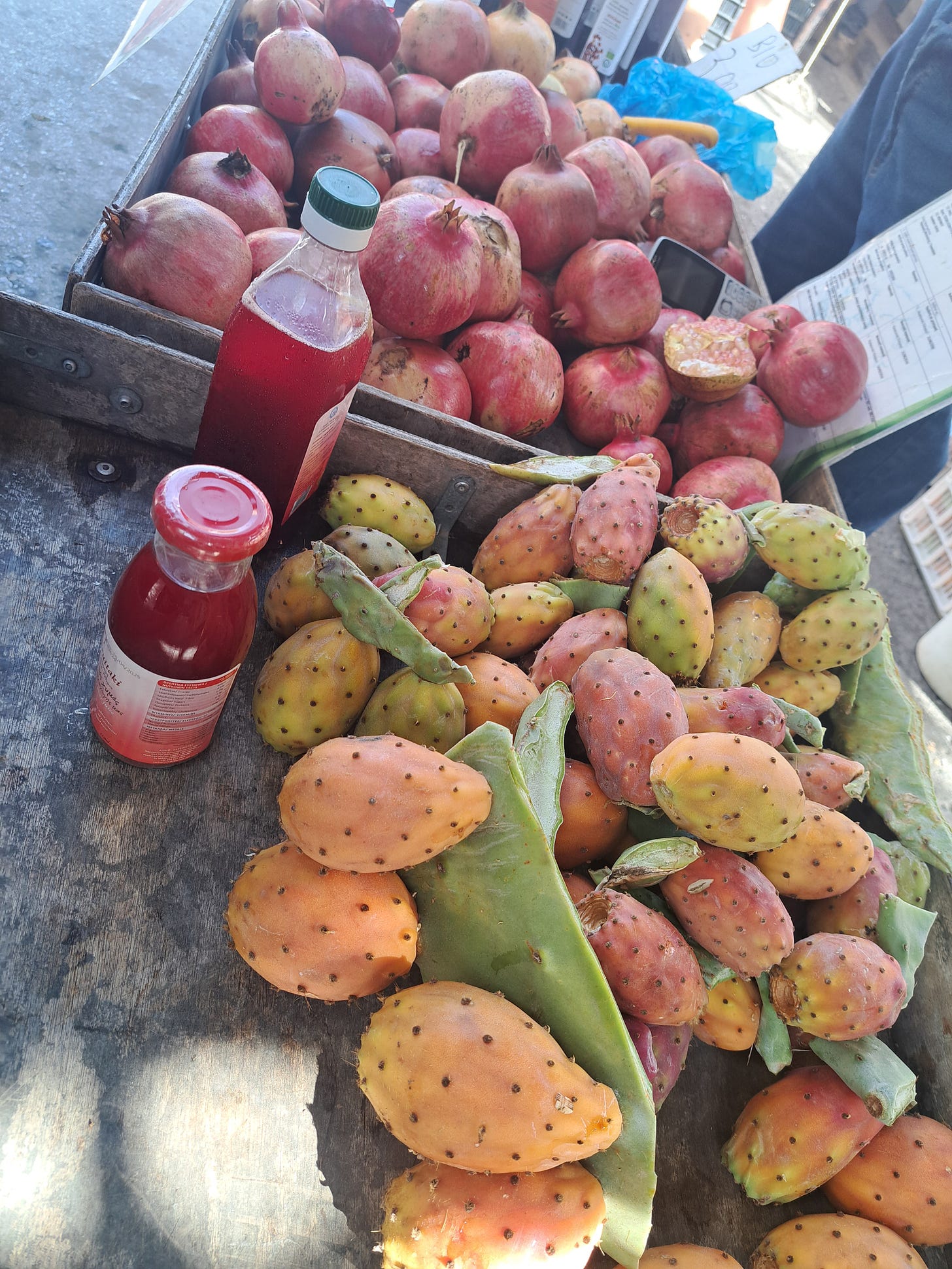

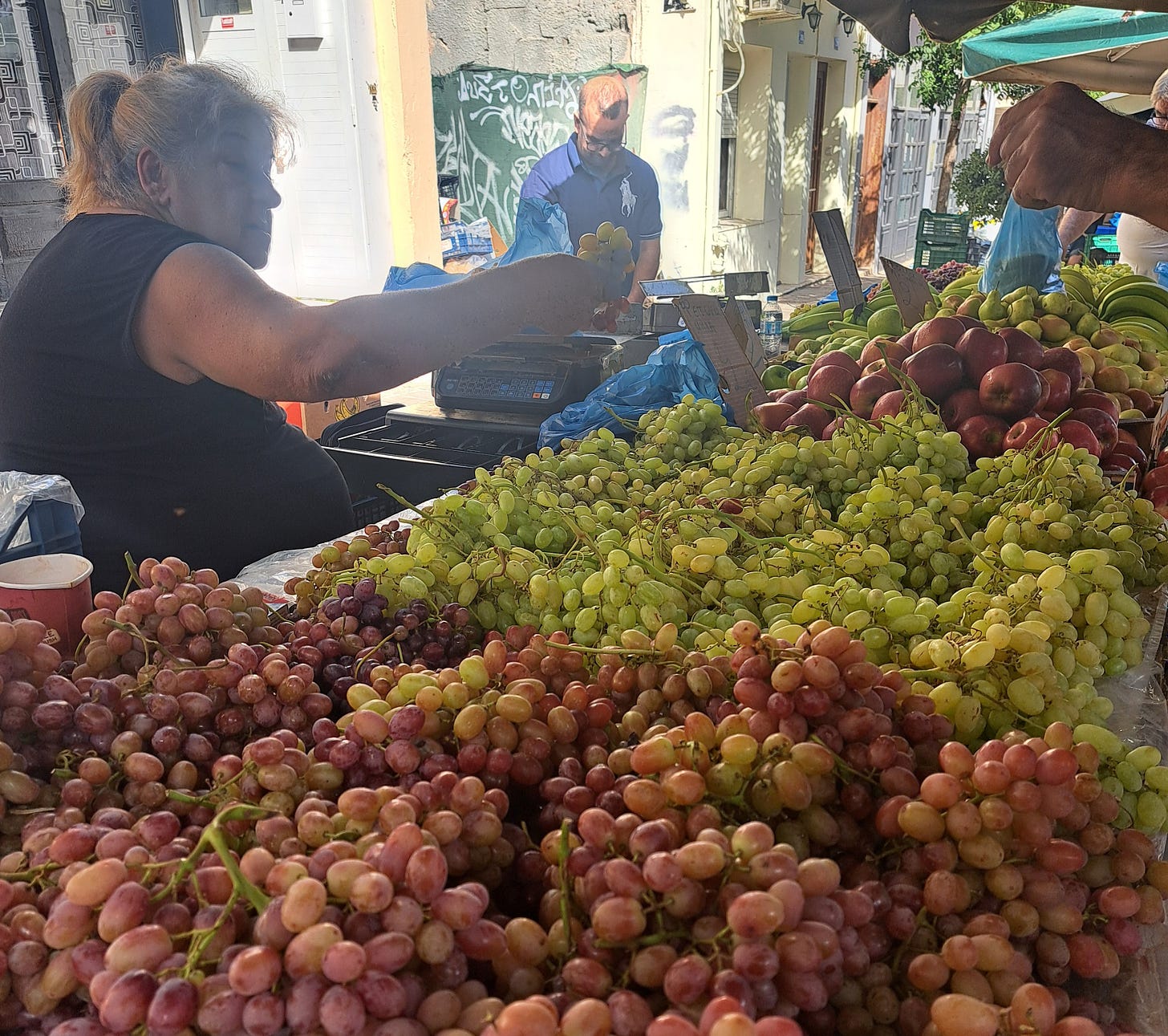
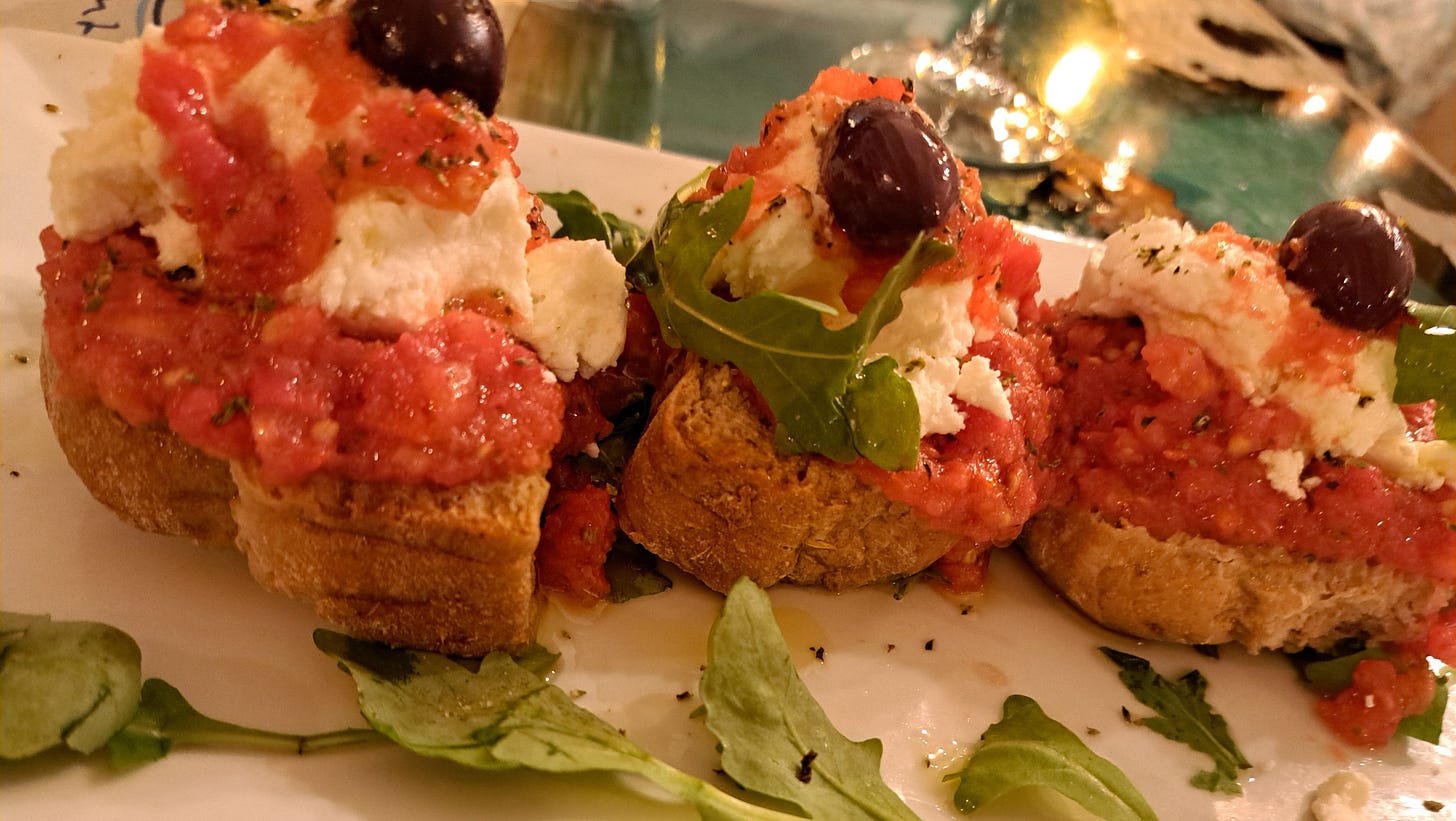
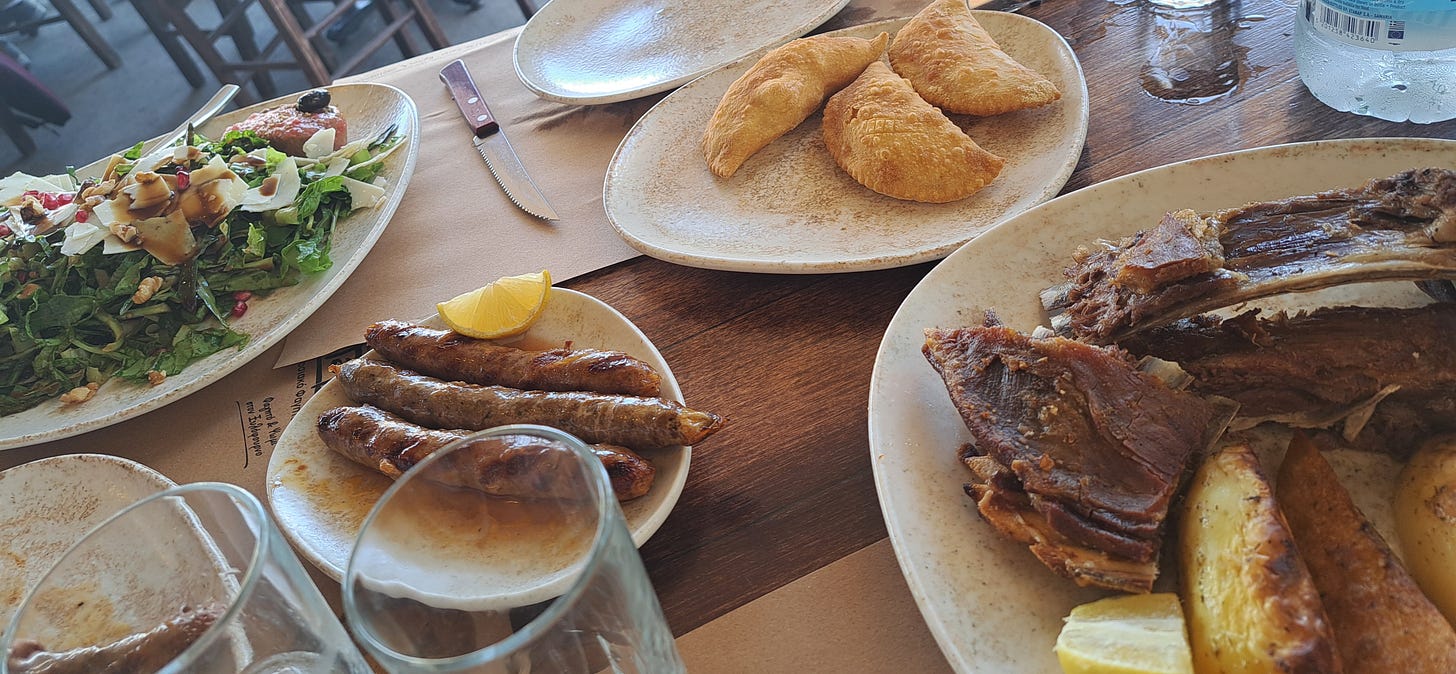
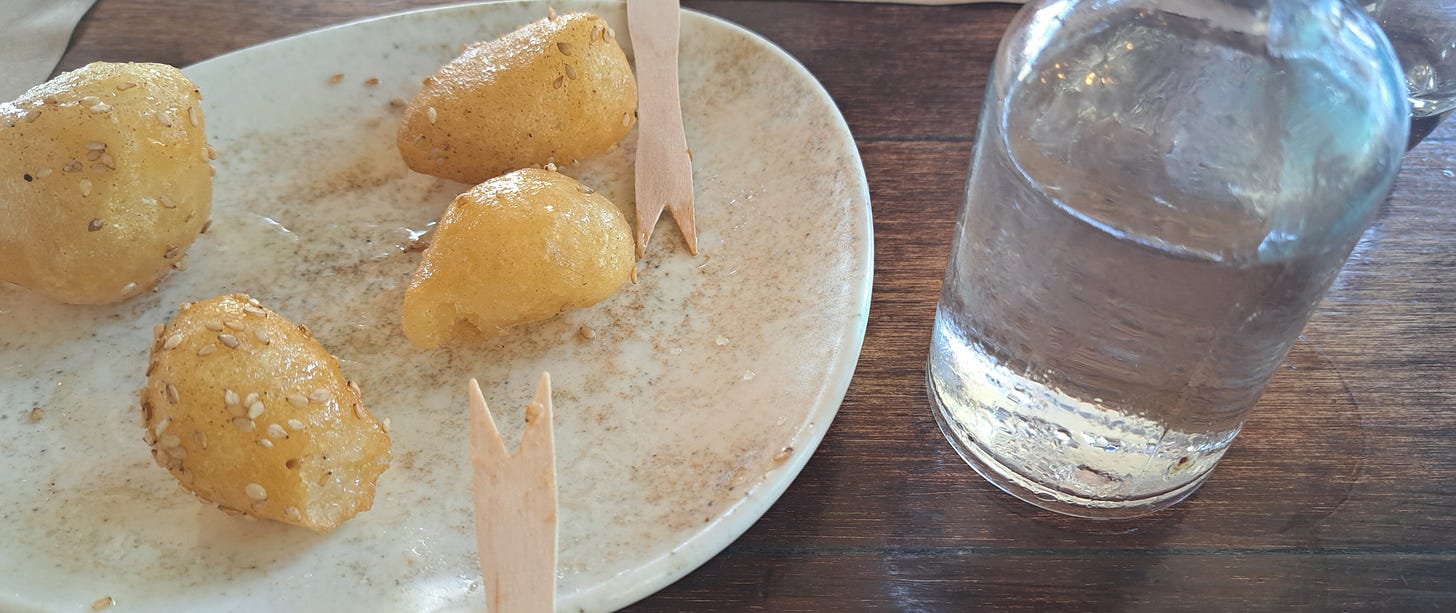
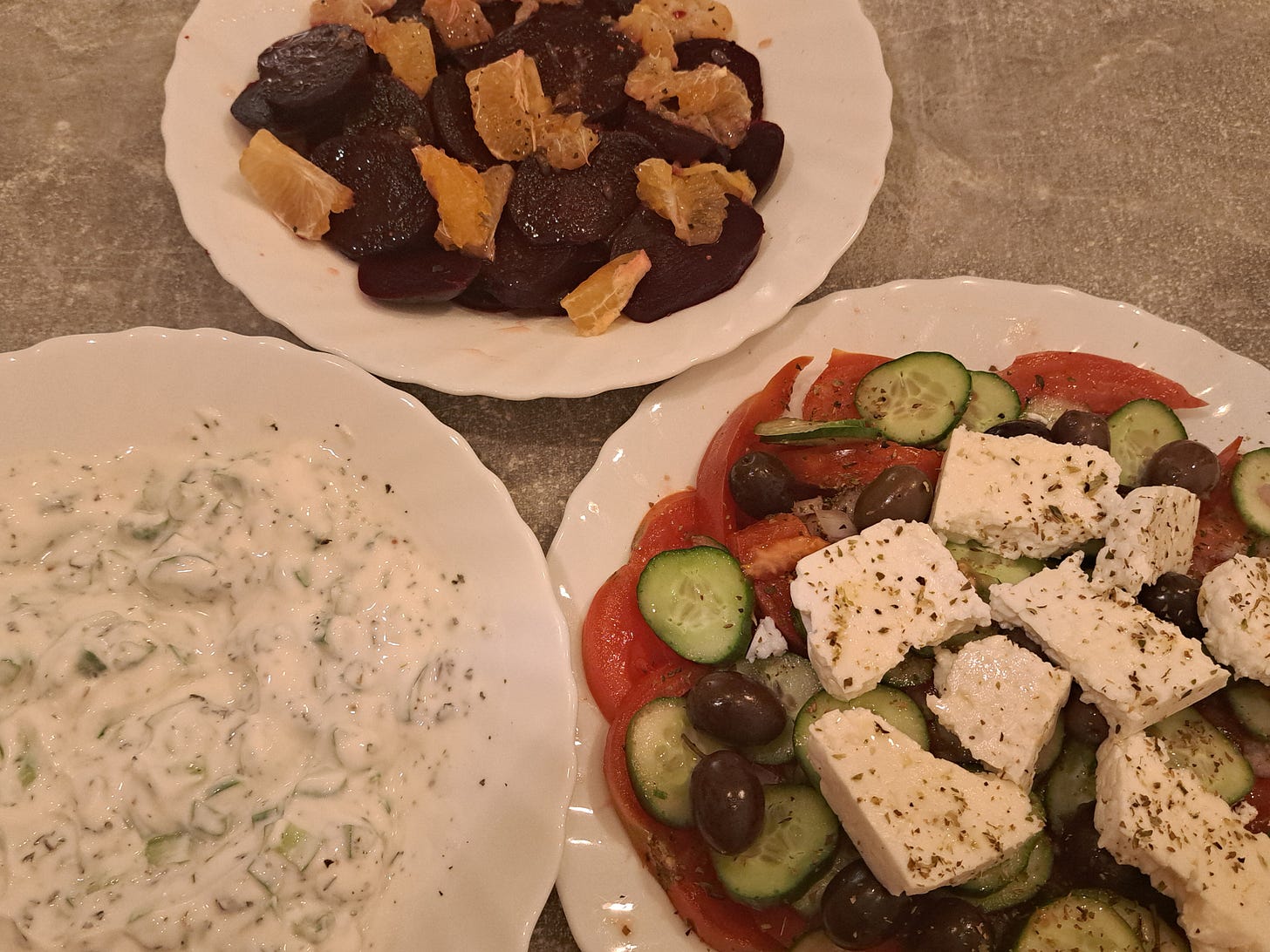
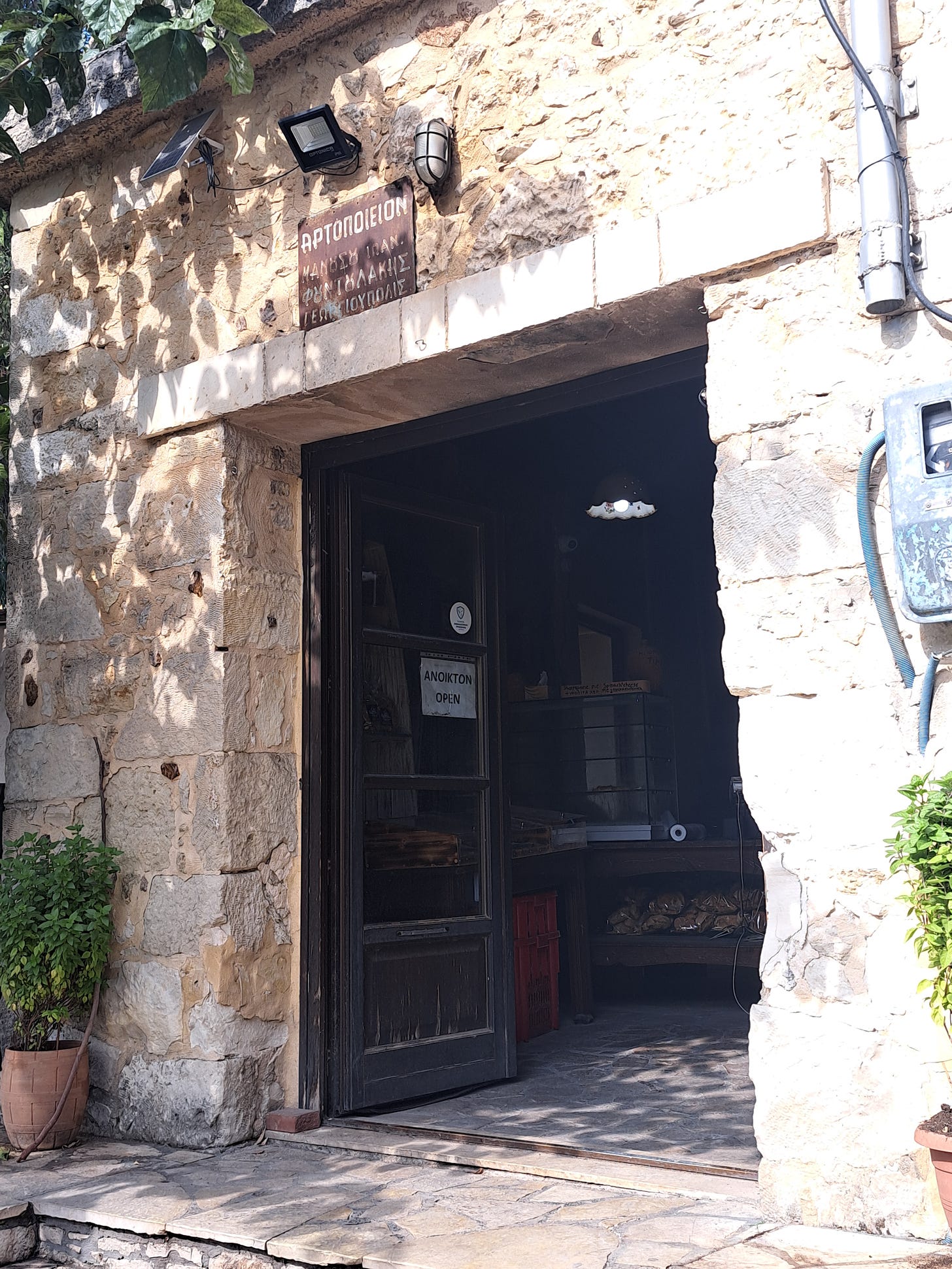
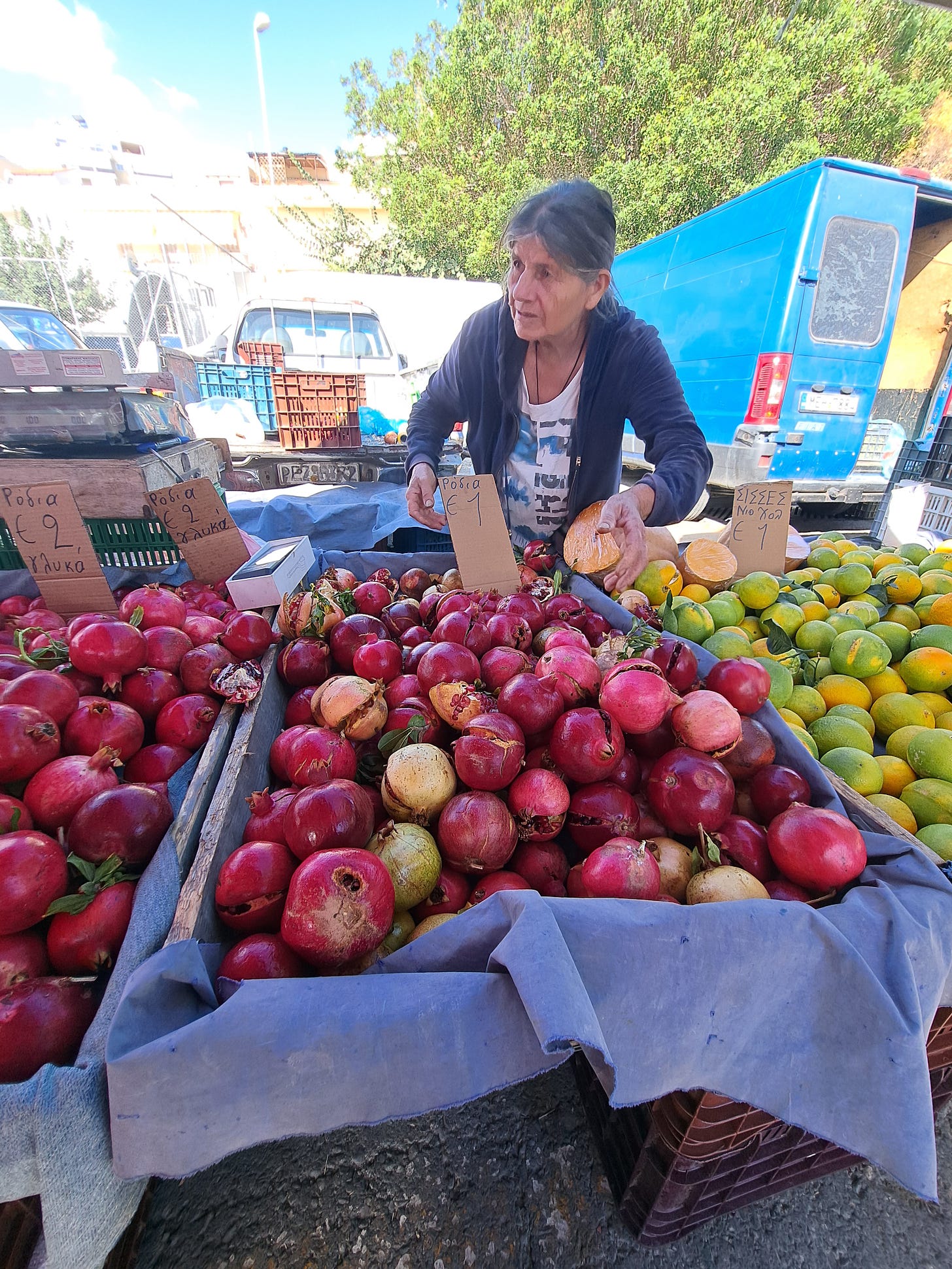
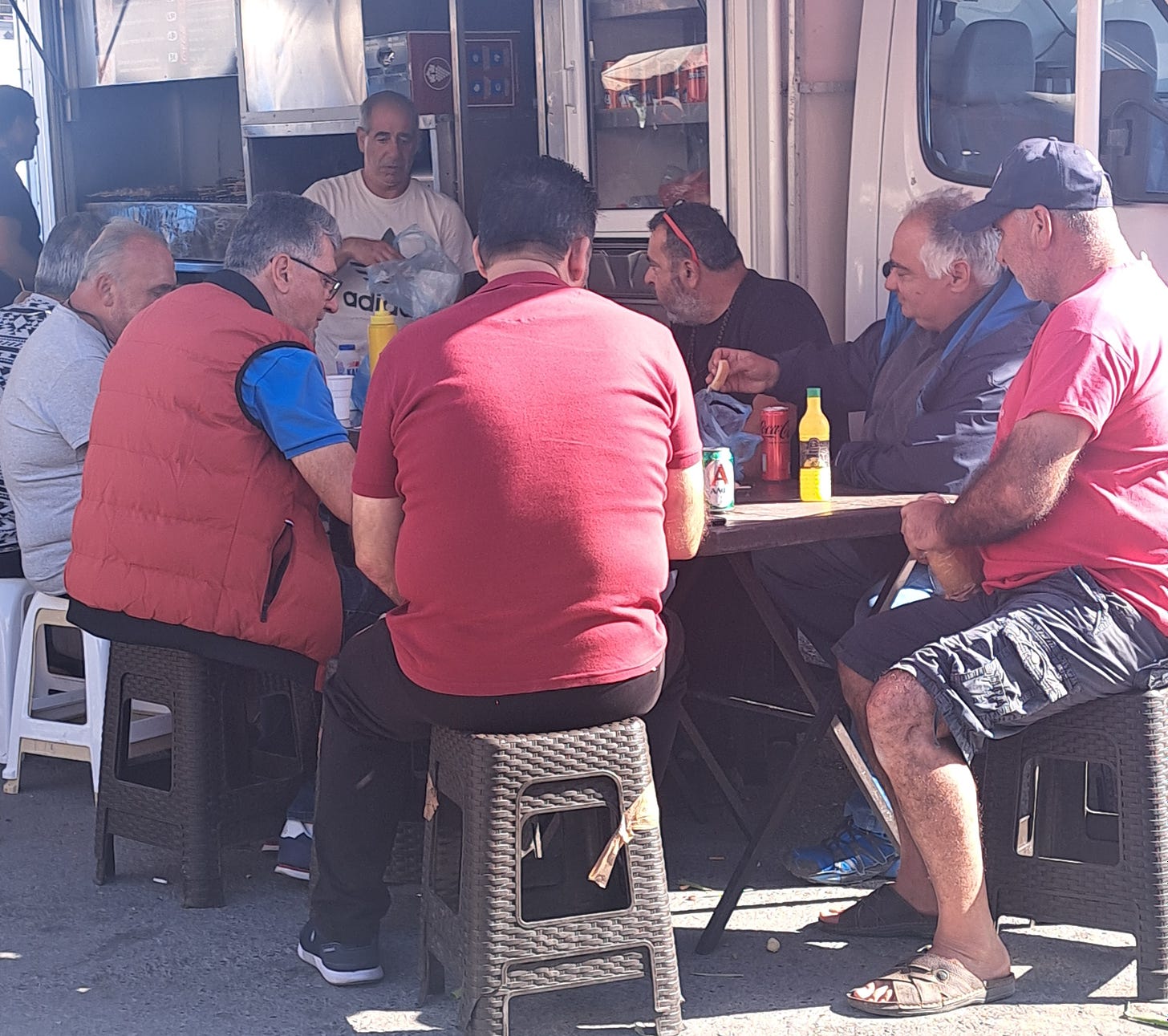
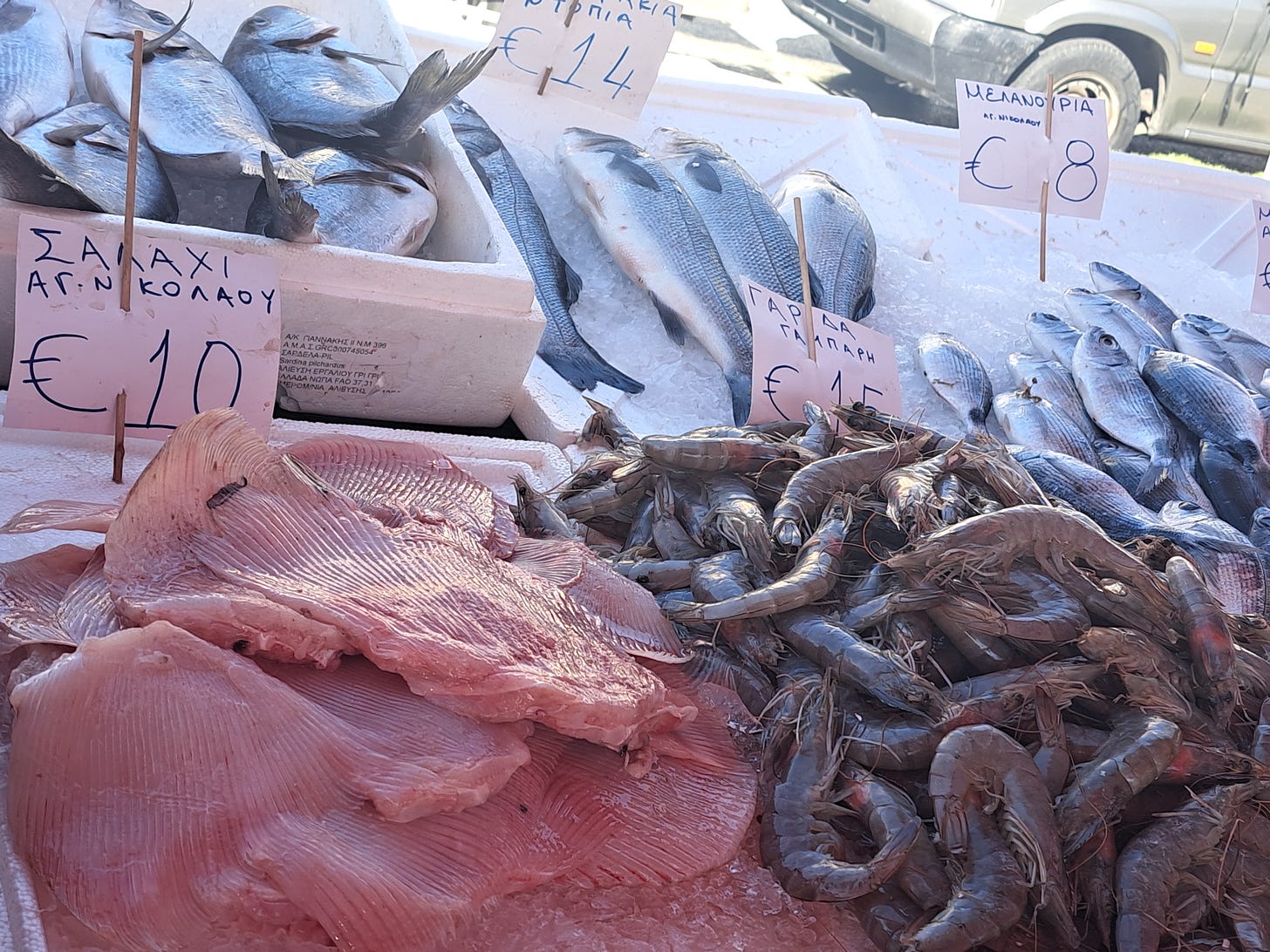
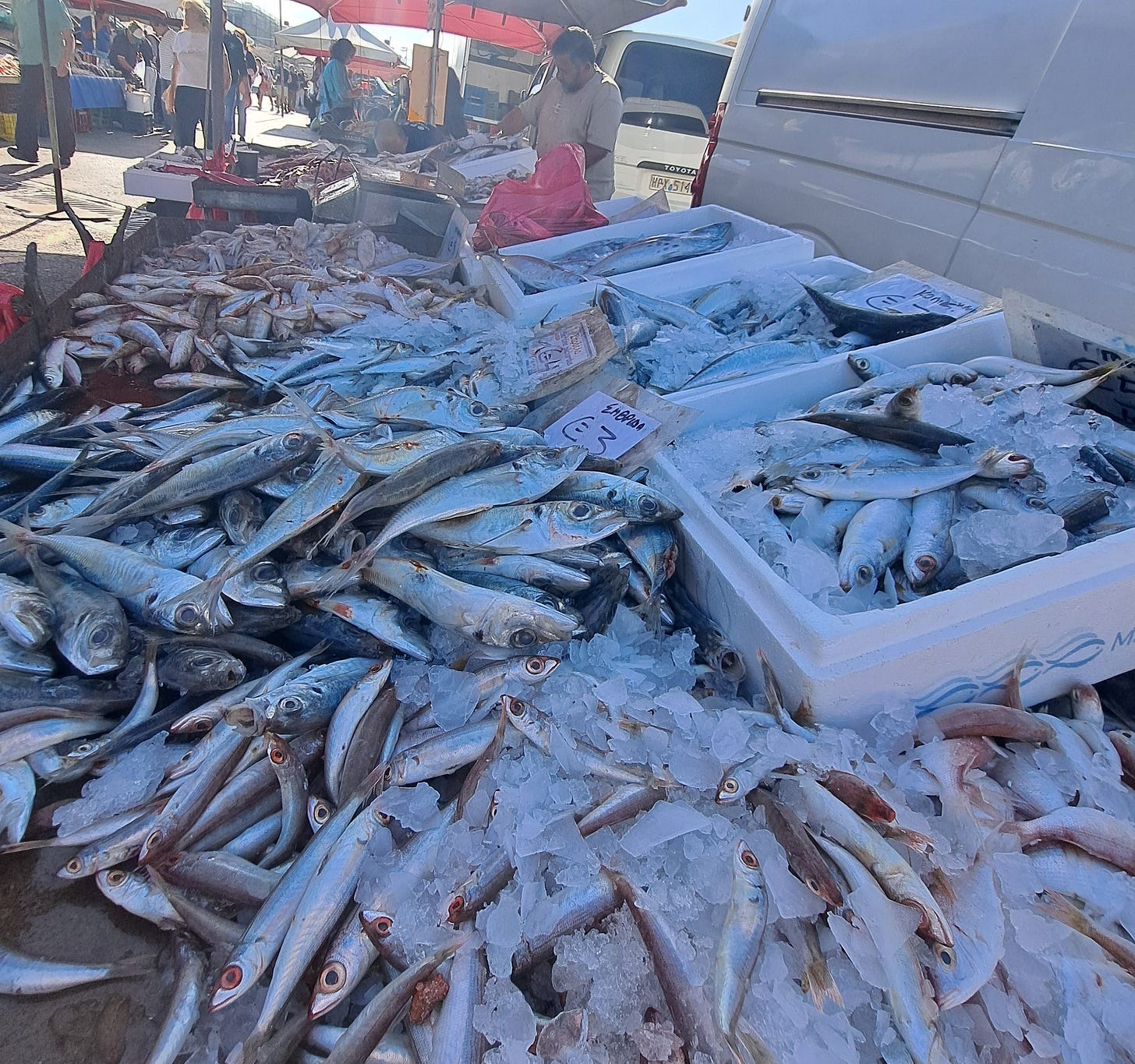
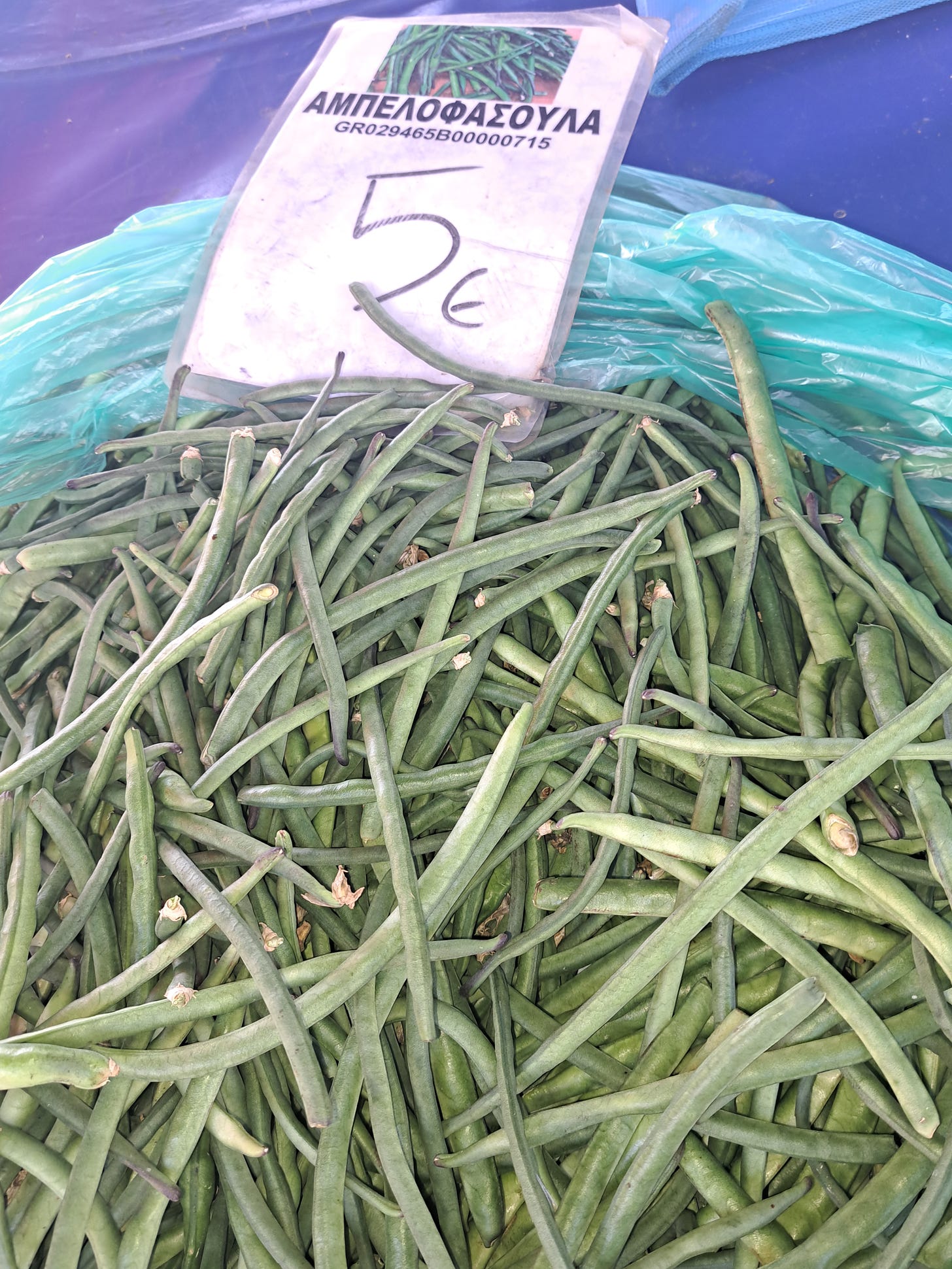
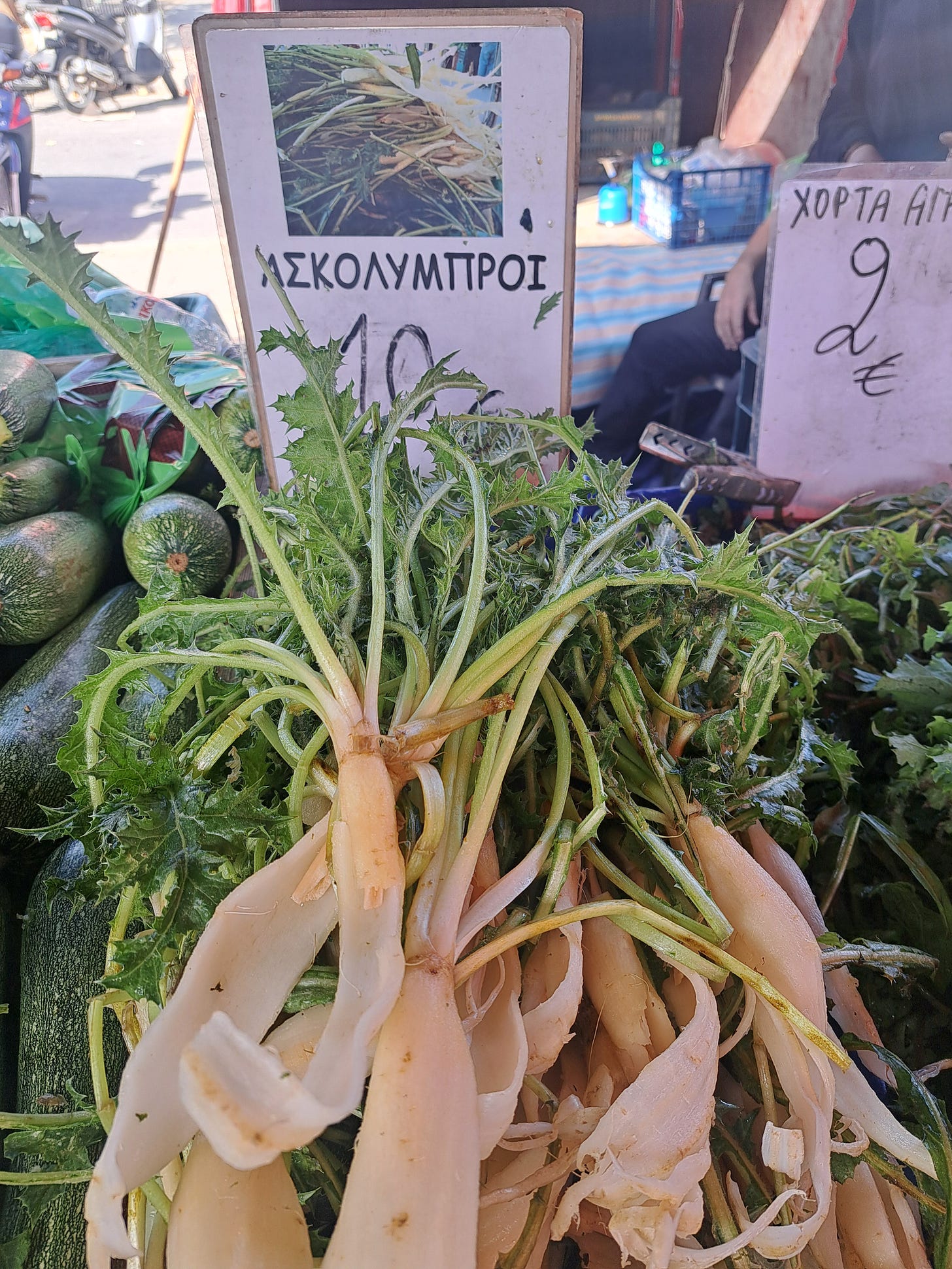
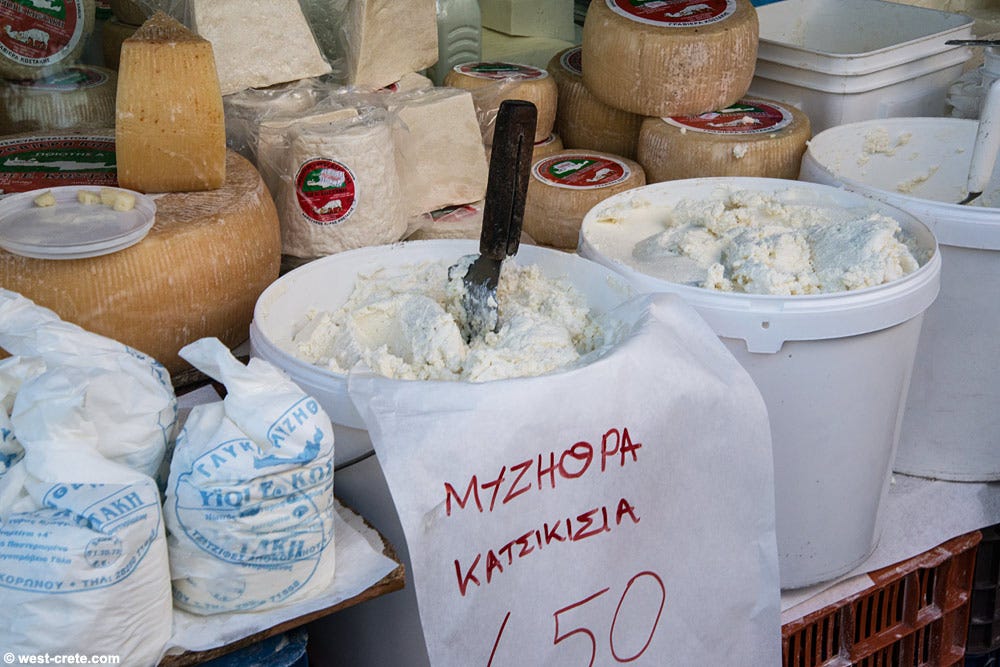
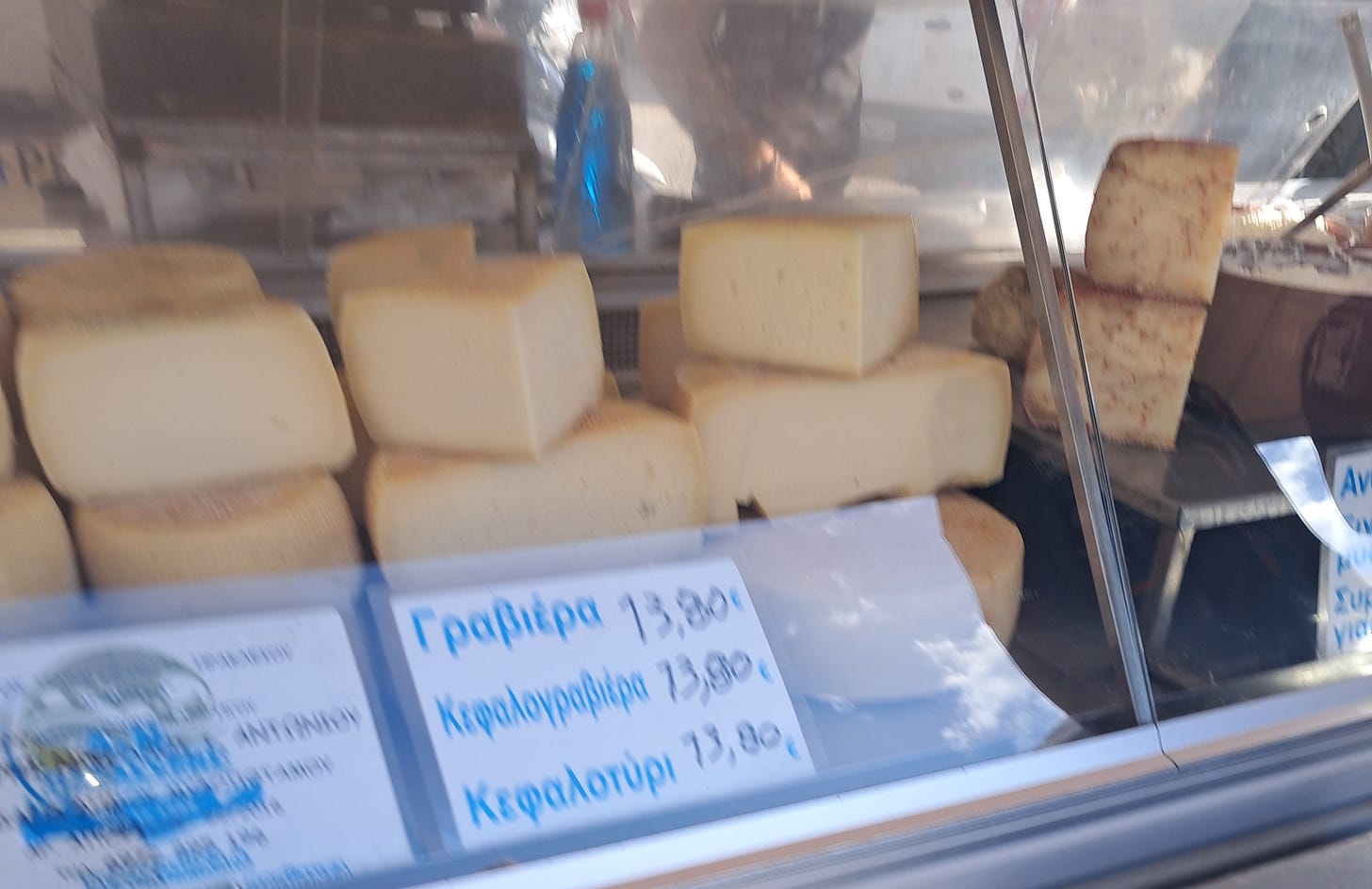
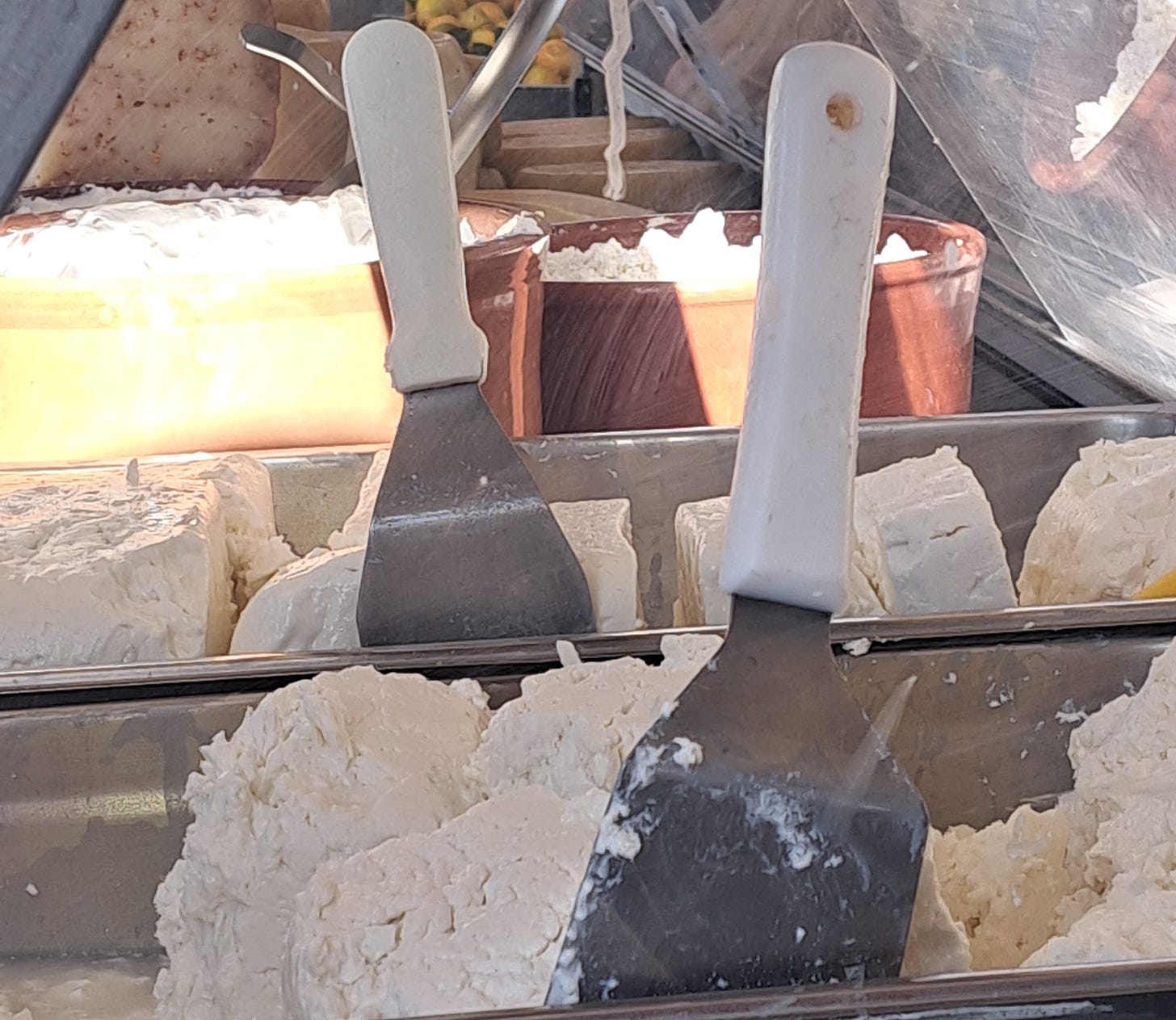
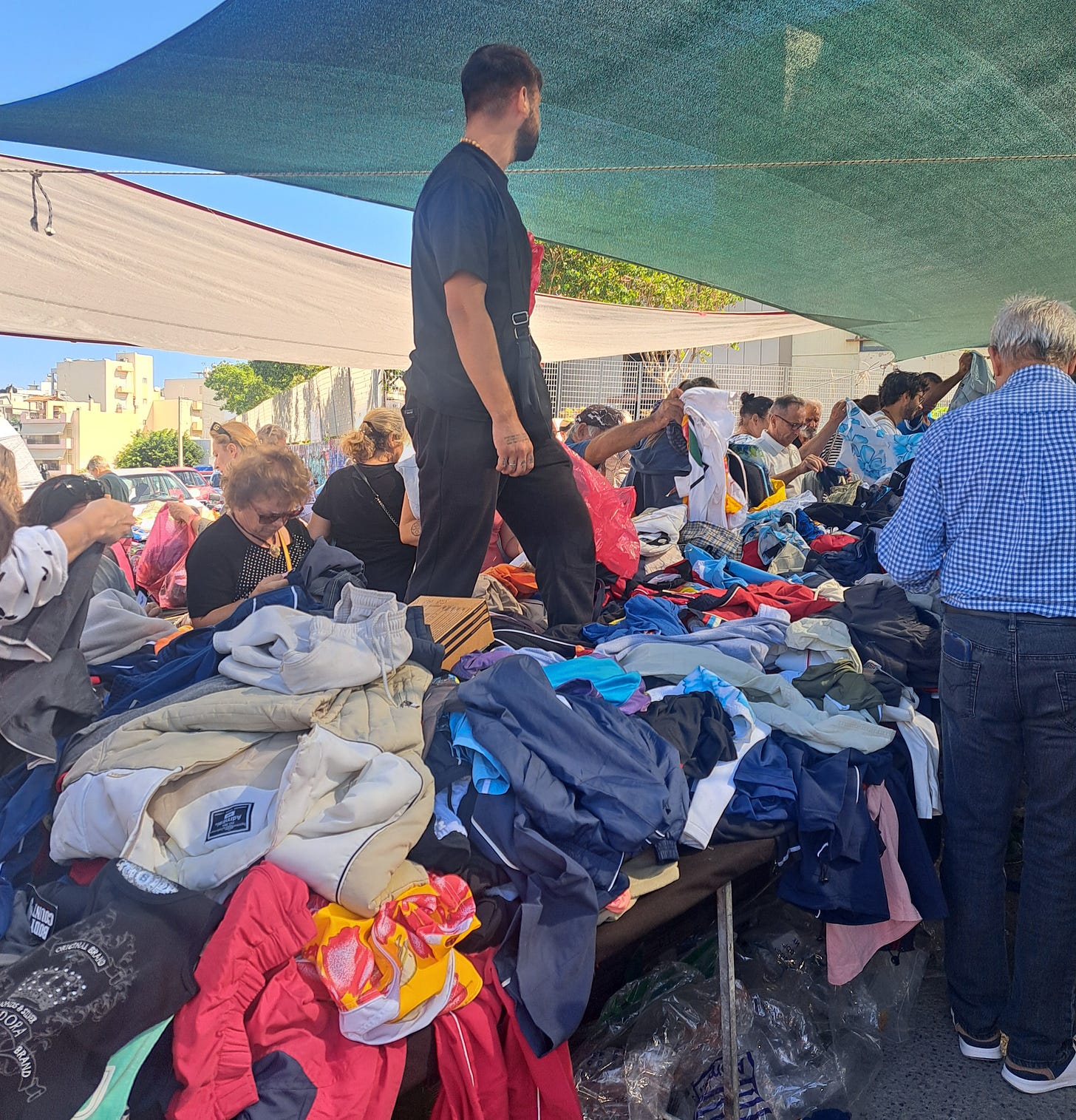
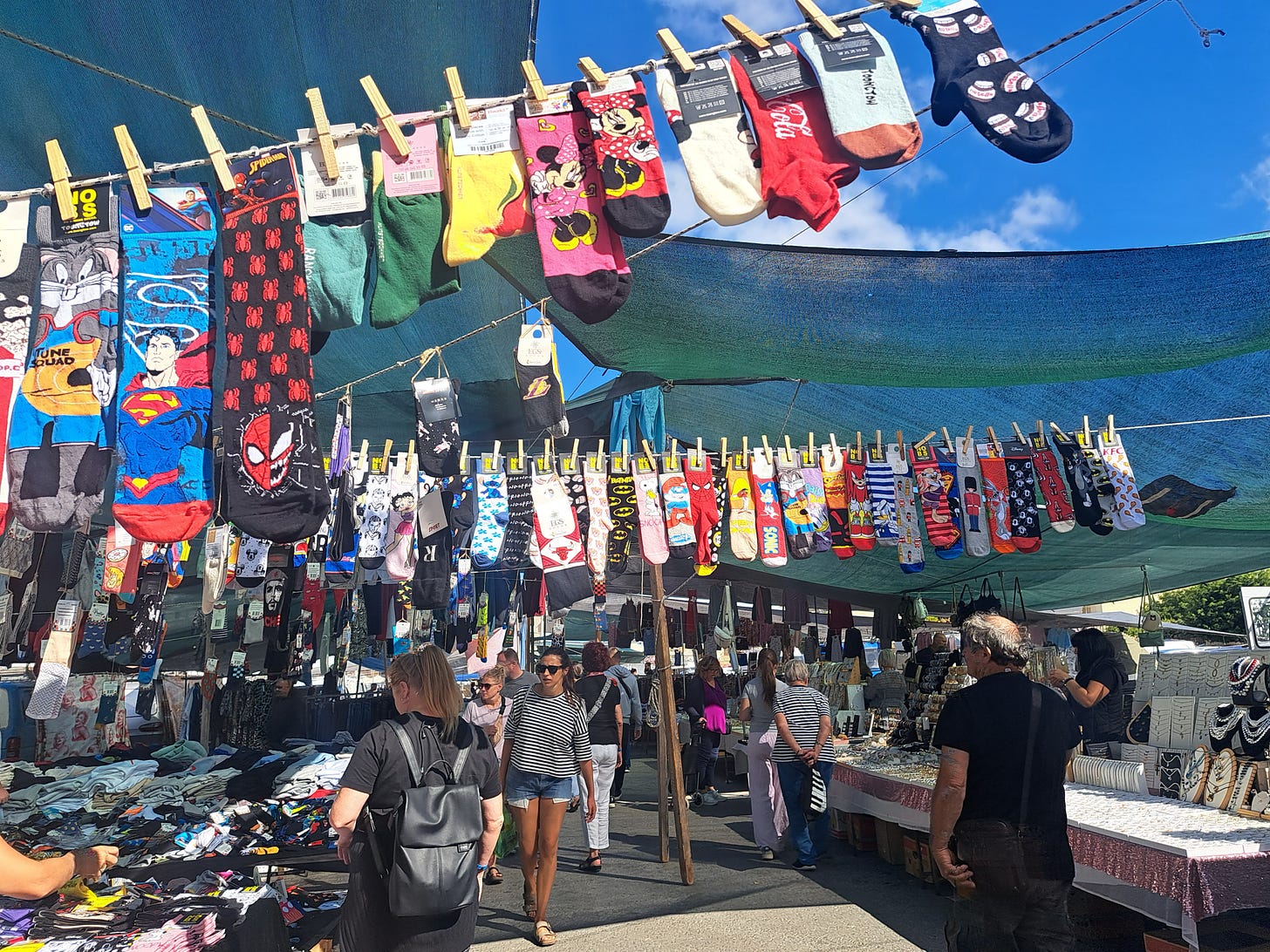
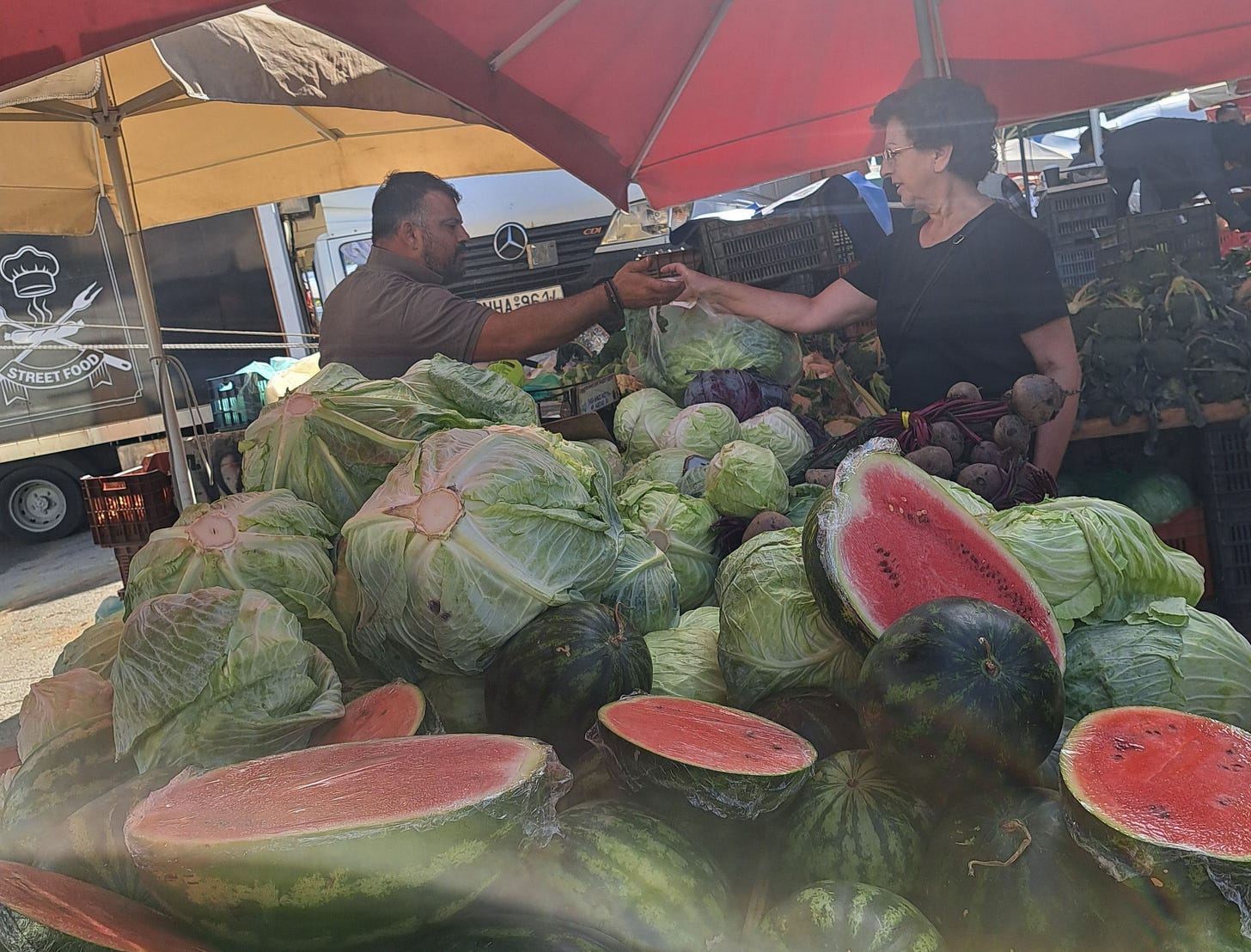
Well done for your bus adventure. I love Crete and you brought it alive with your pictures and words. It still always amazes me how, when the produce is good, you don't need much extra flavour. It changes the way I make meals when abroad.
Oh thank you, that was marvellous! The colour of those pomegranates! I wonder if those asklimbros thistles are like the tagarninas you get in the Cádiz area of Spain (maybe elsewhere too, but that’s the only place I have seen them. Cádiz has a lovely little market.)